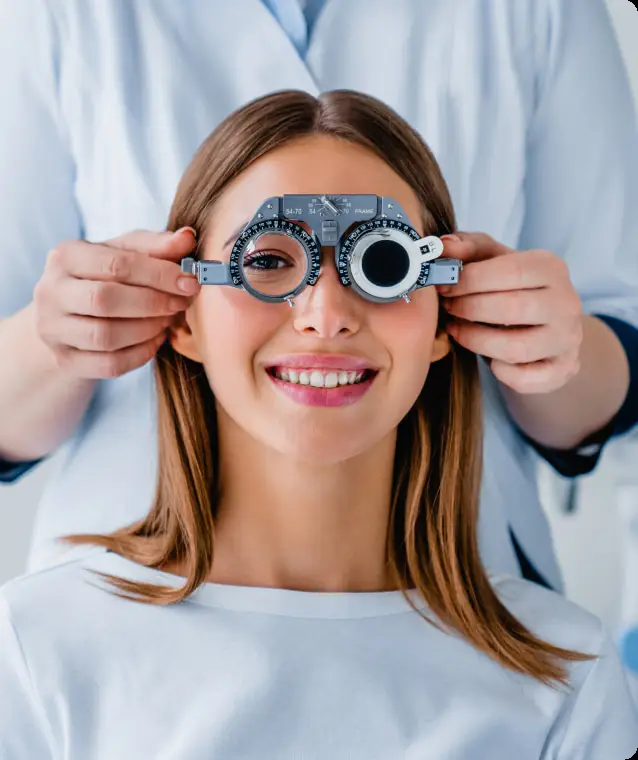If you or your loved ones live with diabetes or have noticed changes in your vision, it is strongly recommended to schedule a comprehensive diabetic eye screening. This allows the specialist to identify the cause and detect any early signs of diabetic eye disease before vision is affected.
Moorfields Eye Hospitals UAE
At Moorfields Eye Hospital Dubai and Abu Dhabi, we extend the legacy of Moorfields Eye Hospital London, providing world-class eye care in the UAE. Our comprehensive services cover diagnostics, treatment, and surgery for various eye conditions, all managed by specialist teams.
Dedicated adult and paediatric departments
State of the art facilities and technology
Multicultural and multilingual teams
First certified center of excellence in the region
Accredited by JCI & ACHSI
200+
15+
350,000+
50+
Driven by your vision
Our world-class facilities at Moorfields Eye Hospital Dubai and Abu Dhabi provide a seamless experience and the highest standards of care for our patients.
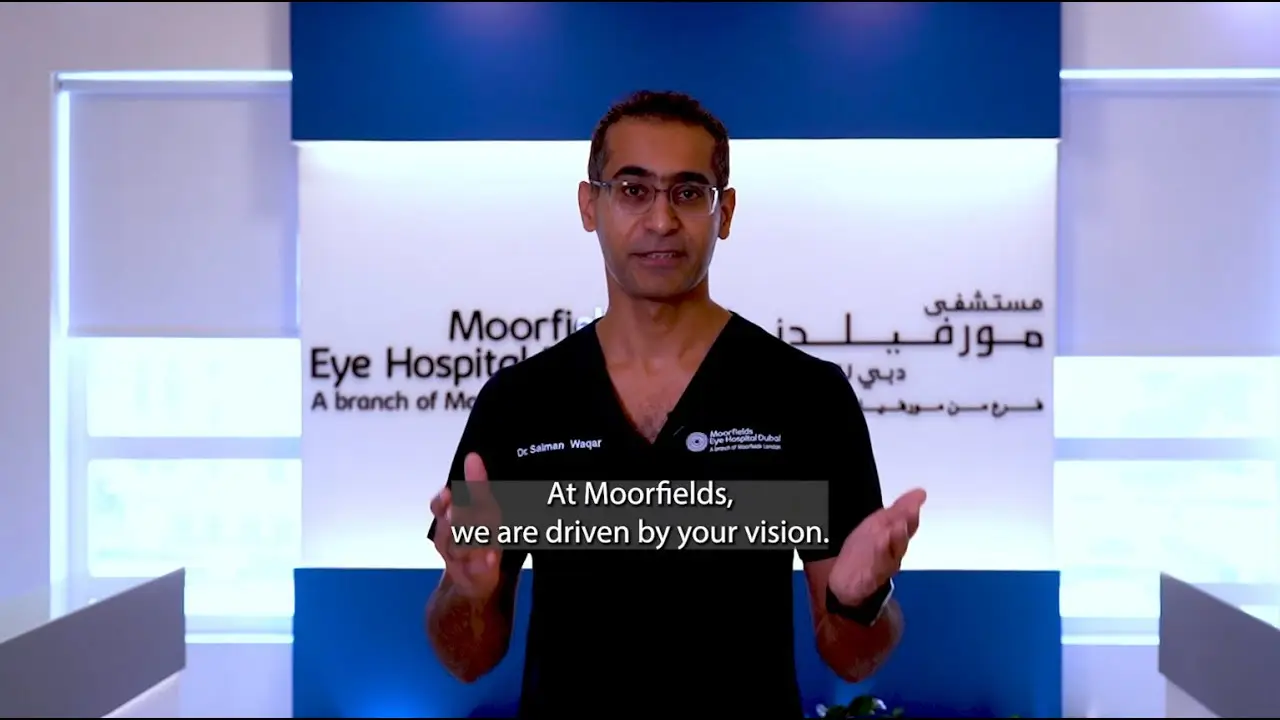
Our Services
We provide a comprehensive range of eye care services for children and adults by specialised teams of ophthalmologists, optometrists and orthoptists.
Our Specialists
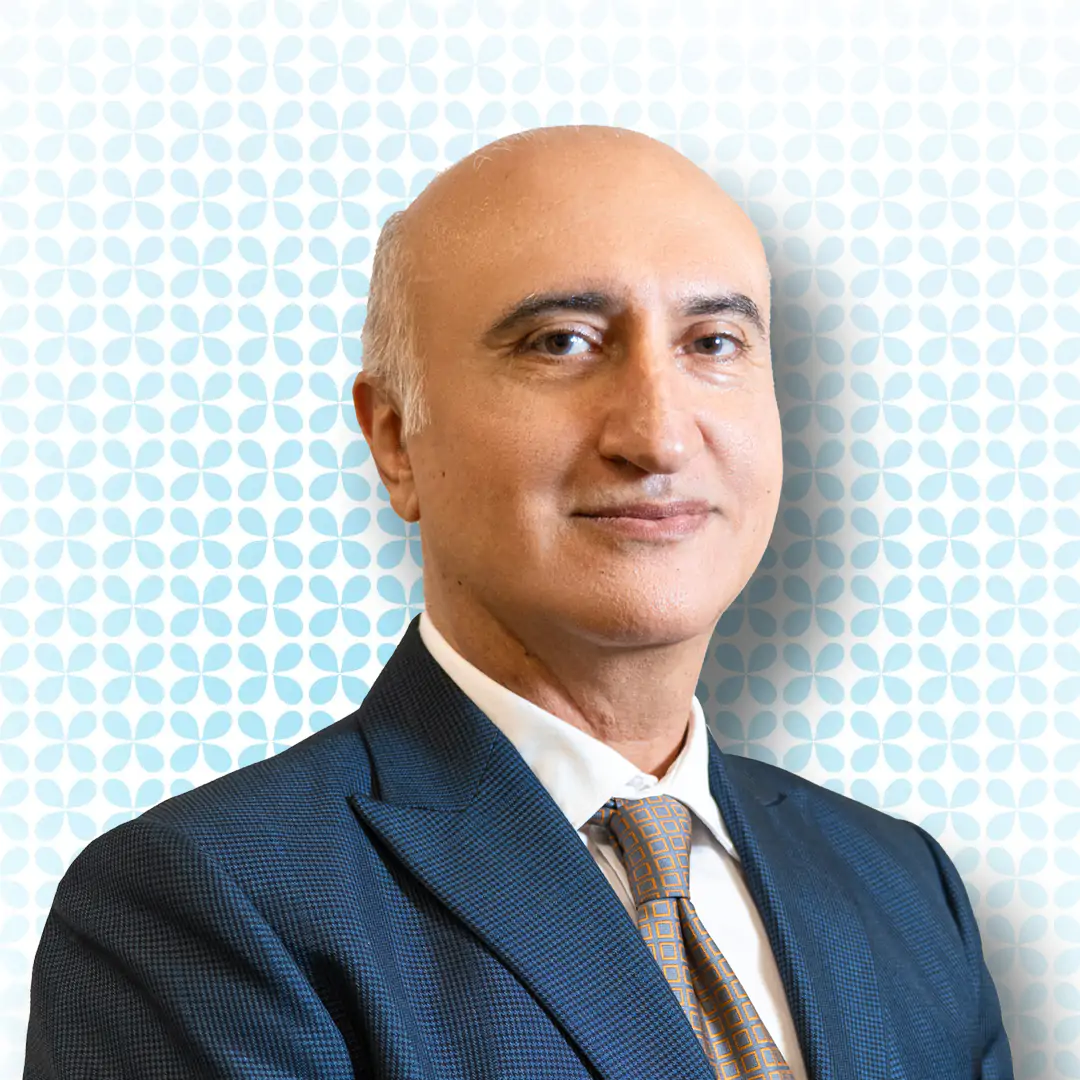
Dr. Raef Emile
Consultant Ophthalmologist in Cataracts and Vitreoretinal SurgeryDr. Raef Emile Hanna Guirguis is our Consultant Ophthalmologist at Moorfields Eye Hospital Abu Dhabi based at Imperial College Diabetes & Endocrine Centre, Zayed Sports City, Abu Dhabi. Dr. Raef completed his primary healthcare services in 2000, Dr. Raef received extensive training as an intern ophthalmologist in Gamal Abdel-Nasser Hospital, which is one of the most heavily laden tertiary referral centres in Alexandria, Egypt. Following this he completed his fellowship at the Alexandria Faculty of Medicine where he undertook his MD studies involving advanced surgical and medical retina subspecialities. He has a wealth of exceptional surgical skills and experience in providing healthcare for ophthalmic patients, with special skills in the field of vitreo-retinal surgery. Dr. Raef has a proven track record of experience in the fields of surgical management of diabetic retinopathy, cataract and retinal detachment for more than 30 years.

Dr. Ammar Safar
Chief Medical Officer and Consultant Ophthalmologist & Vitreoretinal SurgeonGCAA Approved Specialist Aviation Medical Examiner
Professor of Ophthalmology (Adjunct)
Dr. Ammar Safar is an American Board-Certified Ophthalmologist specialising in vitreoretinal diseases and surgery at Moorfields Eye Hospital Dubai in Dubai Healthcare City.
He is currently an adjunct Professor of Ophthalmology at Mohammad Bin Rashed University and the Chief Medical Officer of Moorfields Eye Hospitals in the United Arab Emirates.
Dr. Safar undertook his medical training in Syria before moving to the United States for post-graduate training. He specialised in Ophthalmology at Georgetown University in Washington, DC, where he also served as a Chief Resident. He then acquired an additional 2-year fellowship training in Vitreoretinal Diseases & Surgery at the University of Texas, Southwestern Medical Center in Dallas, Texas, USA. Dr. Ammar then went on to hold the position of Assistant and later Associate Professor and Director of Vitreoretinal Surgery at the Department of Ophthalmology, Jones Eye Institute, the University of Arkansas for Medical Sciences, in the United States. He then relocated to the UAE, where he was a Consultant Vitreoretinal Surgeon and President of Medical Staff at a private general hospital in Dubai. In addition to his work in private practice, Dr. Ammar has undertaken research and clinical trials in areas such as diabetic retinopathy and age-related eye diseases and published and presented extensively. His research has also resulted in advances in retinal vascular diseases (discovering new management options for diabetic retinopathy and vascular occlusive disorders) and macular degeneration (new approaches for treating exudative macular degeneration).
Among his many honorary awards, Dr. Ammar was the inaugural recipient of The Martha Wood Bentley endowed Chair of Ophthalmology at the University of Arkansas. He is a member of several professional associations, including the American Academy of Ophthalmology, the American Society of Retina Specialists, the European Society of Retina Specialists, the American Society of Cataract and Refractive Surgery, The Association for Research In Vision and Ophthalmology (ARVO), Arab-American Medical Association, Research to Prevent Blindness, and a fellow of the American College of Surgeons.

Dr. Esmaeil Arbabi
Medical Director and Consultant Ophthalmologist in Corneal transplant, Cataract & Refractive SurgeryDr. Esmaeil Mohammad Arbabi is a Consultant Ophthalmologist with excellent surgical experience including all types of corneal transplants (DMEK, DSAEK, PDEK, DALK, PKP), ocular surface reconstruction, complex cataract and laser refractive surgery.
Prior to joining Moorfields Eye Hospital Center, he was Consultant Ophthalmic Surgeon (Cornea, Cataract & Laser Refractive Surgery) and the Lead for Refractive Services at Royal Liverpool University Hospital, Liverpool, United Kingdom.
Dr. Esmaeil holds several prestigious degrees and certifications in the field of cataract and refractive surgery including MSc in Cataract and Refractive Surgery, Certificate in Laser and Refractive Surgery (CertLRS) from Royal College of Ophthalmologist and Fellow of European Board of Ophthalmology Subspecialty Diploma in Cataract and Refractive Surgery (FEBOS-CR).
He is a member of Royal College of Ophthalmologists, European Society of Cataract and Refractive Surgeons, European Board of Ophthalmology, UK Cross-Linking Consortium, EYE -LAW CHAMBERS – Medicolegal Expert and Expert, Association of Personal Injury Lawyers (APIL).
He is instrumental in high quality papers in various peer reviewed journals and numerous scientific and ophthalmology publications. He is also an examiner for the University of Leeds and the University of Liverpool and for the European Board of Ophthalmologist (FEBO exam).
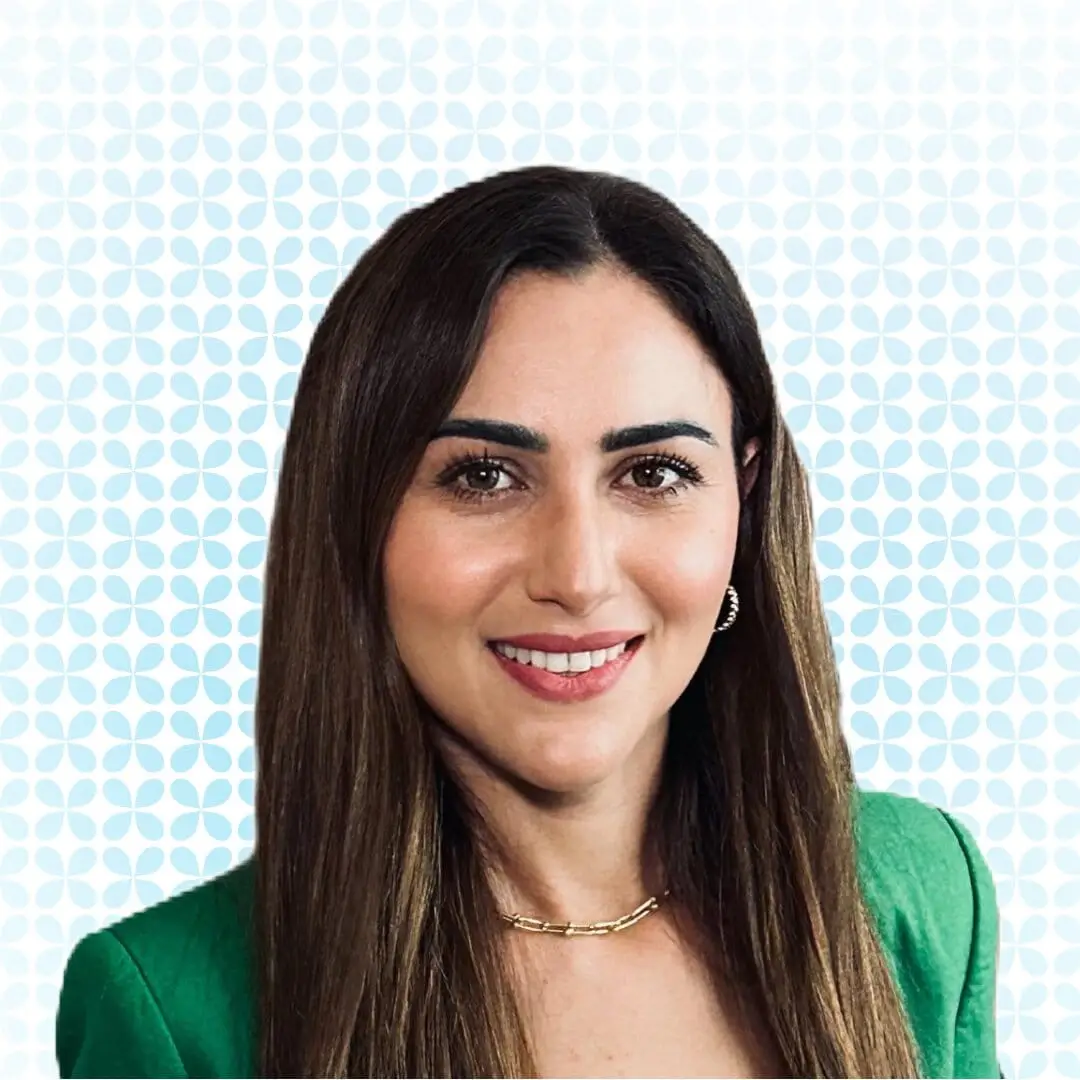
Dr. Alia Issa
Aesthetic Oculoplastic SurgeonDr. Alia Issa is an Aesthetic Oculoplastic Surgeon, specialising in surgical and non-surgical aesthetic eye treatments at Moorfields Eye Hospital Dubai in Dubai Healthcare City.
Dr. Alia is a German board-certified ophthalmologist who completed her medical school and residency training at leading institutions in Germany. She also holds a PhD in Ophthalmology from the University of Dresden, Germany.
She went on to expand her expertise and subspecialise in Aesthetic Oculoplastics by completing a Fellowship training in London at the Ezra Clinic and an Honorary Fellowship in Oculoplastics at the world-renowned Moorfields Eye Hospital in London.
Dr. Alia has over 13 years of regional and international experience in Ophthalmology, including in Germany, the United Kingdom, and the United Arab Emirates.
In her career, she has practised in leading medical institutions such as Moorfields Eye Hospital London, and Schlosspark Hospital Berlin, an academic hospital of the Charite University Hospital Berlin, Gemrany.
She is a member of the German Ophthalmic Society.

Dr. Alaa A. Mohamed Abou Attawan
Consultant Ophthalmologist in Retina, Uveitis and Diabetic RetinopathyDr. Alaa A. Mohamed Abou Attawan has 15 years of experience in Ophthalmology. He is joining us from Moorfields Eye Centre at Bedford Hospital, United Kingdom, where he was a Consultant Ophthalmologist (Retina). Prior to that, he practiced in Tawam Hospital – Al Ain for 5 years where he set up the foundation and established the Retina service in Al Ain City – UAE.
In his role at Moorfields Eye Hospital Center Abu Dhabi, Dr. Attawan will be working as Consultant Ophthalmologist.
Dr. Attawan graduated from University of Aden, Yemen in 2002 obtaining his Bachelor of Medicine degree. Following his graduation, he moved to the UK to pursue his foundation medical training and further specialty training program in Ophthalmology at the Newcastle upon Tyne Hospitals NHS Foundation Trust and Yorkshire and the Humber School of Ophthalmology working across various hospitals in the UK such as Leeds Teaching Hospitals NHS Trust and Royal Victoria Infirmary from 2008 till 2015. Upon completion of his training, Dr Attawan was awarded the Certificate of Completion of Training (CCT).
He was also a Vitreo Retinal Surgery Fellow at Nottingham University Hospitals, UK from 2015 till 2016.
Dr. Attawan has been a Member since 2008 and a Fellow of the Royal College of Ophthalmologists since 2014. Dr Attawan was a former associate Tutor of the Royal College of Ophthalmologist in London and is actively involved in teaching and research. He has 10 Publications in various prestigious journals and is a well-known speaker at national and regional levels.
He was also one of the Top 10 consultant nominated by SEHA 2022 and he was the Retina service lead and co-founder of Retina service in Al Ain city UAE
Dr. Attawan’s scope of practice covers Cataract surgery, Diabetic eye disease, Retinal Vein occlusion, age-related macular degeneration, emergency eye trauma, and surgery. primary and complex Retinal detachment surgery. Macular hole and Membrane peel surgery.
Dr. Alaa is a Fellow of the Royal College of Ophthalmologists (FRCOphth).

Dr. Fahd Quhill
Consultant Ophthalmologist in Medical Retina and Ocular inflammatory disease (Uveitis)Clinical Professor Of Ophthalmology (Adjunct)
Dr Fahd Quhill is a Consultant Ophthalmologist specialising in Medical Retina and Ocular inflammatory disease at Moorfields Eye Hospital Dubai in Dubai Healthcare City.
Dr Fahd specialises in the assessment and management of uveitis and inflammatory eye diseases (uveitis, infectious diseases, autoimmune diseases of the eye) as well as medical retinal disease, such as diabetes, macular degeneration, inherited retinal disease and retinal vascular disease.
He has broad experience in the diagnosis and management of complex inflammatory eye diseases, including the use of immunosuppression, as well as in treating retinal disease.
Dr. Fahd trained in Ophthalmology in the United Kingdom at Oxford, Birmingham and London, completing three Medical Retinal Fellowships in Birmingham, Wolverhampton and Moorfields Eye Hospital, London.
He has undertaken research and served as principal investigator in numerous macular degeneration, retinal vein occlusion and diabetic macular oedema trials. He has published 27 research papers on retinal and ocular inflammatory disease in leading journal/s such as Ophthalmology, British Journal of Ophthalmology and Eye, among others.
He is a member of several professional bodies, including the Royal College of Ophthalmologists.

Dr. Imad Hakim
Consultant Ophthalmologist in Cataract and Refractive vision correction surgeryDr. Imad Hakim is a Consultant Ophthalmologist, specialised in Cataract and Refractive vision correction surgery at Moorfields Eye Hospital Dubai in Dubai Healthcare City.
He holds a graduate degree from the University of Aleppo in Syria, obtained in 2002. Dr. Hakim also holds a certificate in Ophthalmology from Ludwig Maximillian University of Munich, Germany. He undertook his sub specialty training in Cataract and Refractive surgery at Realeyes Eye Clinic in Munich, Germany.
His areas of expertise are in Femto laser assisted Cataract Surgery (FLACS), Refractive vision correction surgery (LASIK, LASEK, TransPRK, PTK, Implantable Contact Lenses ICLs, Multifocal Intraocular Lenses IOLs and Add-On IOL ), Keratoconus, Phototherapeutic Keratectomy (PTK) Laser Eye Surgery and General Ophthalmology.
He has more than 15 years of regional and international experience in countries including Germany and UAE.
In his career, he has practiced in leading medical institutions such as Realeyes Eye Clinic in Munich, Germany as well as American Hospital in Dubai, U.A.E.
He has published research papers on Cataracts and Retina in leading journals.
He is a member of the European Society of Cataract & Refractive Surgeons (ESCRS), The German Committee for Refractive Surgery (KRC), Commission of the German Ophthalmological Society (DOG) and Professional Association of German Ophthalmologists (BVA).

Dr. Imran Jawaid
Consultant Ophthalmologist in Paediatric Ophthalmology and Strabismus surgeryDr. Imran Jawaid is a Consultant Ophthalmologist, specialised in Paediatric Ophthalmology and Strabismus, at Moorfields Eye Hospital Dubai in Dubai Healthcare City.
He holds a Bachelor of Medicine, Bachelor of Surgery (MBChB) degree in Medicine from the University of Leicester, School of Medicine, graduating with honours in 2010. He is also dual qualified as an Optometrist with a Bachelor of Science (HONS) degree in 2003. Dr. Imran has completed his Fellowship with the Royal College of Ophthalmologists (FRCOphth) and obtained his Certificate of Completion of Training (CCT) in Ophthalmology in 2020.
Dr. Imran has more than 15 years of experience in Ophthalmology in the United Kingdom and has completed a post-CCT fellowship in Paediatric Ophthalmology and Strabismus at Birmingham Children’s Hospital, UK. Most recently he was a Consultant Ophthalmologist and Head of Service for Ophthalmology at Nottingham University Hospitals, NHS Trust, a large tertiary centre for ophthalmic referrals.
He has undertaken research in myopia, visual impairment, diabetic macular oedema and emergency ophthalmology, amongst other areas and has published over 10 research papers in leading journals. In addition to his research, Dr. Imran is a keen educator and has taught at different UK medical schools and contributed to book chapters in Ophthalmology.
He is a member of the Royal College of Ophthalmologists (FRCOphth) and is the recipient of several internationally acclaimed awards and recognitions.

Dr. Luisa M. Sastre
Consultant Ophthalmologist in Medical Retina and Cataract SurgeryGCAA Approved Specialist Aeromedical Examiner
Dr. Luisa Sastre is a Consultant Ophthalmologist in Medical Retina and Cataract Surgery at Moorfields Eye Hospital Dubai in Dubai Healthcare City.
Dr. Luisa holds a Spanish medical degree from the Universidad Autonoma Medical School and completed her ophthalmology residency at Hospital Universitario Gregorio Maranon in Madrid, Spain . She is board certified in Intensive Care medicine and ophthalmology. She also holds a PhD from Universidad Autonoma de Madrid and a Master’s degree in Healthcare Organisation Leadership from ESADE Business School.
She has more than 20 years of combined regional and international experience in countries including Spain and UAE.
She has practised in leading medical institutions such as Hospital Universitario Fundación Jiménez Díaz and Hospital Universitario El Escorial, Madrid, Spain.
She has presented various papers in national and international congresses and journals and organised educational courses on cataract surgery and medical retina for peers and opticians.
She is a member of “Surgical Eye Expeditions International”, a nonprofit humanitarian organisation that hosts clinic sites worldwide. She is also a member of Sociedad Española de Oftalmologia (SEO).
In addition to her clinical work, Dr. Luisa volunteers in various charitable campaigns worldwide to treat patients suffering from cataracts who otherwise have difficulty accessing medical care.

Dr. Miguel Morcillo
Consultant Ophthalmologist in Cornea, Cataract and Refractive vision correction surgeryDr. Miguel Morcillo is a Consultant Ophthalmologist specialising in Cornea, Cataract and Refractive (Vision Correction – LASIK, LASEK, TransPRK) Surgery at Moorfields Eye Hospital Dubai in Dubai Healthcare City.
Dr. Miguel holds a Spanish Degree in Medicine from the Universitat de Valencia. He completed his Residency in Ophthalmology under the MIR (Medico Interno Residente) system of the Spanish Ministry of Health. He has more than 25 years of experience, most of which was attained in Spain. He also worked in Italy and finally moved to the UAE in 2017 and has been practising in the UAE since that time. Dr. Miguel started his career working with Clinica Baviera, the largest private ophthalmology group in Europe, in Madrid and Valencia. He helped develop many of the refractive treatments offered today, such as LASIK, LASEK, ICLs and multifocal IOLs, in addition to collaborations with other hospitals to provide high-quality cataract and refractive surgery to patients. Dr. Miguel trained in cornea surgery at NIIOS Eye Institute (Rotterdam) and, since then became an experienced educator for other surgeons in the fields of the anterior segment and refractive surgery.
He has been a member of “Surgical Eye Expeditions International” since 1999, an American non-government organisation that arranges eye camps worldwide. Dr. Miguel has assisted several eye charity camps in numerous countries of Africa, in addition to Peru, Panama and India, providing free eye care and performing surgeries to those who could not afford it in less developed areas.
His research efforts include surgical topics and outcomes such as Ultrathin LASIK, Keratoconus screening, ICLs, and multifocal IOLs, among others. He has presented various papers in national and international congresses and journals and organised educational courses on refractive surgery for peers and opticians.
He is a member of Sociedad Española de Oftalmologia (SEO), the Panamerican Association of Ophthalmology (PAAO) and the European Vitreoretinal Society (EVRS).
He is also the recipient of the Dr. P C Mahendra Memorial ACOIN International Award in India in recognition of his charitable work with people in need.

Dr. Nadim Habash
Visiting Consultant Ophthalmologist in Cornea and Ocular Surface DiseasesDr. Nadim Habash is a visiting American Board-Certified Consultant Ophthalmologist specialising in Cornea, Ocular Surface Diseases, and General Ophthalmology at Moorfields Eye Hospital Dubai in Dubai Healthcare City.
Dr. Nadim undertook his speciality training at George Washington University in Washington D.C., U.S.A., where he also served as Chief Resident. He then acquired an additional Cornea and External Disease Fellowship at the University of Florida, Gainesville, U.S.A.
Dr. Nadim is a Diplomate of the American Board of Ophthalmology and a Fellow of the Royal College of Surgeons of Canada FRCS(C).
Over the past 40 years, Dr. Nadim has had extensive experience in Corneal transplantation and Anterior Segment Diseases in several countries, including the United States of America, the Kingdom of Saudi Arabia and the United Arab Emirates.
Dr. Nadim has worked and held leadership and academic positions in prestigious institutions, including the University of Ohio at Toledo, Ohio, U.S.A., the King Faisal Specialist Hospital and the King Khaled Eye Specialist Hospital in Saudi Arabia, and at the American Hospital Dubai, where he held key positions including Chief of Medical Staff, Assistant Chief Medical Officer and Director of Ophthalmology.
Dr. Nadim published several papers about Corneal transplantation, chaired many scientific conferences and symposia, and participated actively in teaching medical students and Ophthalmology residents.
Throughout his career, Dr. Nadim held memberships in several scientific organisations, including a fellowship of the American College of Surgeons, the American Academy of Ophthalmology membership, and many regional and local societies
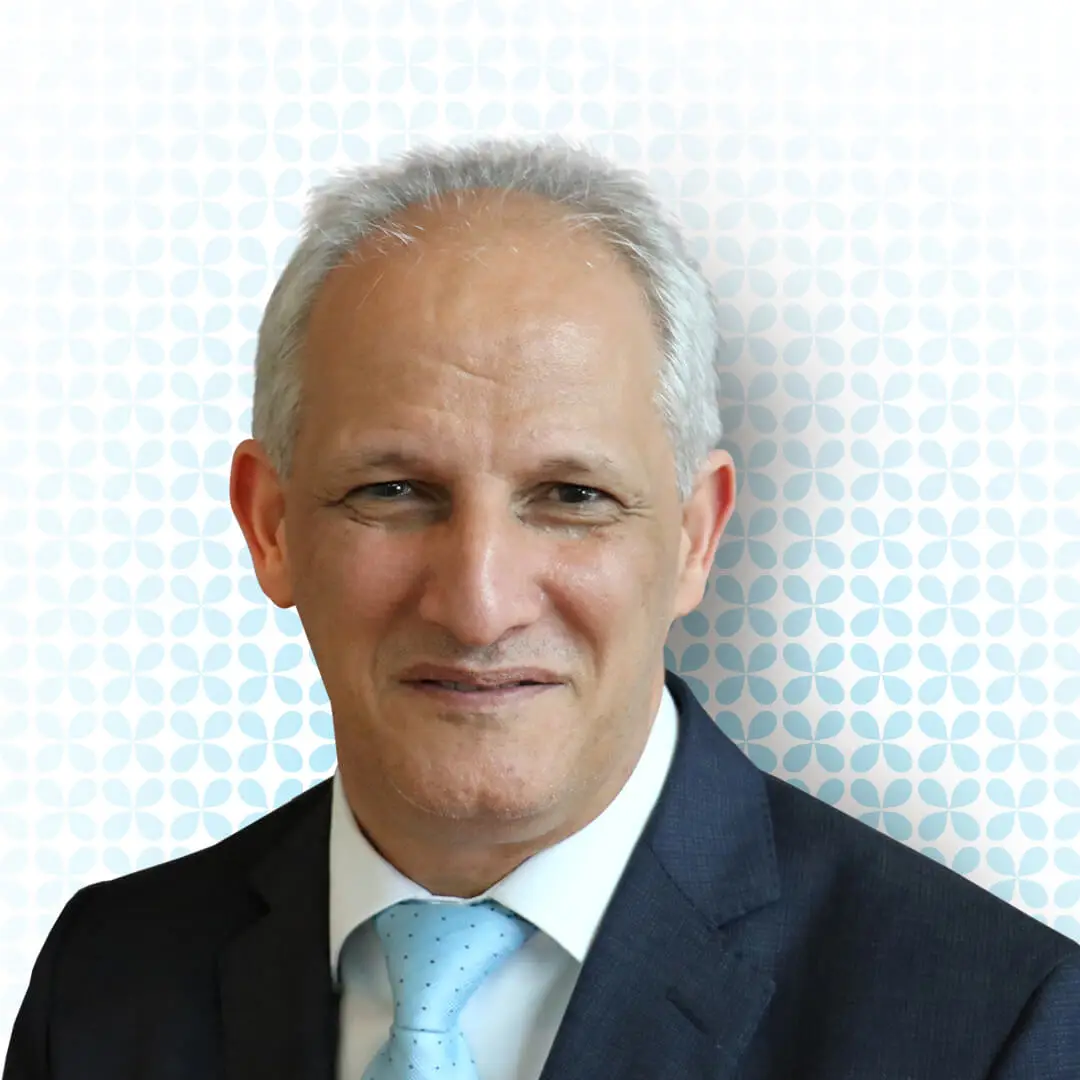
Dr. Osama Giledi
Consultant Ophthalmologist in Cataract, Cornea and Refractive Vision Correction SurgeryGCAA Approved Specialist Aeromedical Examiner
Associate Professor Of Ophthalmology (Adjunct)
Dr. Osama Giledi is a Consultant Ophthalmologist specialising in Cornea, Cataract and Refractive Surgery at Moorfields Eye Hospital Dubai in Dubai Healthcare City.
Dr. Osama is skilled in managing ocular surface problems, including severe dry eye and Stem cell deficiency. He performs small incision phacoemulsification for his cataract surgery and is experienced in using toric and multifocal premium intraocular lenses. Dr. Osama’s expertise in managing complex corneal conditions includes all types of modern corneal graft procedures, such as DALK and DSAEK. He has performed over 23,000 refractive surgeries, including Lasik, LASEK, Intralase LASIK and Trans PRK, and phakic IOLs. He delivers the latest treatment for keratoconus, including Intracorneal ring segments, corneal cross-linking and complex laser treatment.
Dr. Osama graduated from Libya and completed his ophthalmic training in the UK, attaining a Fellowship in Ophthalmology from The Royal College of Edinburgh in 1996. He completed two years of higher subspecialty training fellowship on the anterior segment, Cornea and refractive surgery in 2003 at the prestigious Corneoplastic Unit and Eye Bank at Queen Victoria Hospital, East Grinstead. He worked as a Consultant Ophthalmologist at the Centre for Sight London and the Corneoplastic Unit and Eye Bank at Queen Victoria Hospital. Dr Osama has 22 years of experience in the UK, providing services for anterior segment, Cornea, Refractive and cataract surgery.
In addition to his clinical commitments, Dr. Osama has extensive experience in teaching and training; he is a noted presenter at national and international meetings and has extensive research published in peer-reviewed scientific journals. He is a member of the Royal College Surgeons of Edinburgh, the United Kingdom & Ireland Society of Cataract and Refractive Surgeons, and the European Society of Cataract and Refractive Surgeons.

Dr. Salma Yassine
Specialist in Paediatric Ophthalmology and Adult & Paediatric Neuro-ophthalmologyDr. Salma Yassine is a specialist Ophthalmologist who specialises in Paediatric Ophthalmology and Adult and paediatric Neuro-Ophthalmology at Moorfields Eye Hospital Dubai in Healthcare City Dubai.
She holds a bachelor’s in science (2012) with high distinction and a medical degree (2016) from the American University of Beirut. She finished Her ophthalmology residency at the American University of Beirut Medical Center in 2020 before pursuing a fellowship in neuro-ophthalmology at the University of Minnesota in 2021, followed by another fellowship in pediatric ophthalmology and strabismus at Children’s National Medical Center in Washington DC.
She has international experience in paediatrics and neuro-ophthalmology in countries including the USA and Lebanon.
She has practised in leading medical institutions such as the University of Minnesota and the Children’s National Medical Center in the US.
She has researched intracranial hypertension and nanophthalmos and published research papers on nystagmus and nanophthalmos in leading journals.
She is a member of the American Association for Pediatric Ophthalmology and Strabismus Association (AAPOS) The North American Neuro-Ophthalmology Society (NANOS), and the Lebanese Ophthalmological Society (LOS)
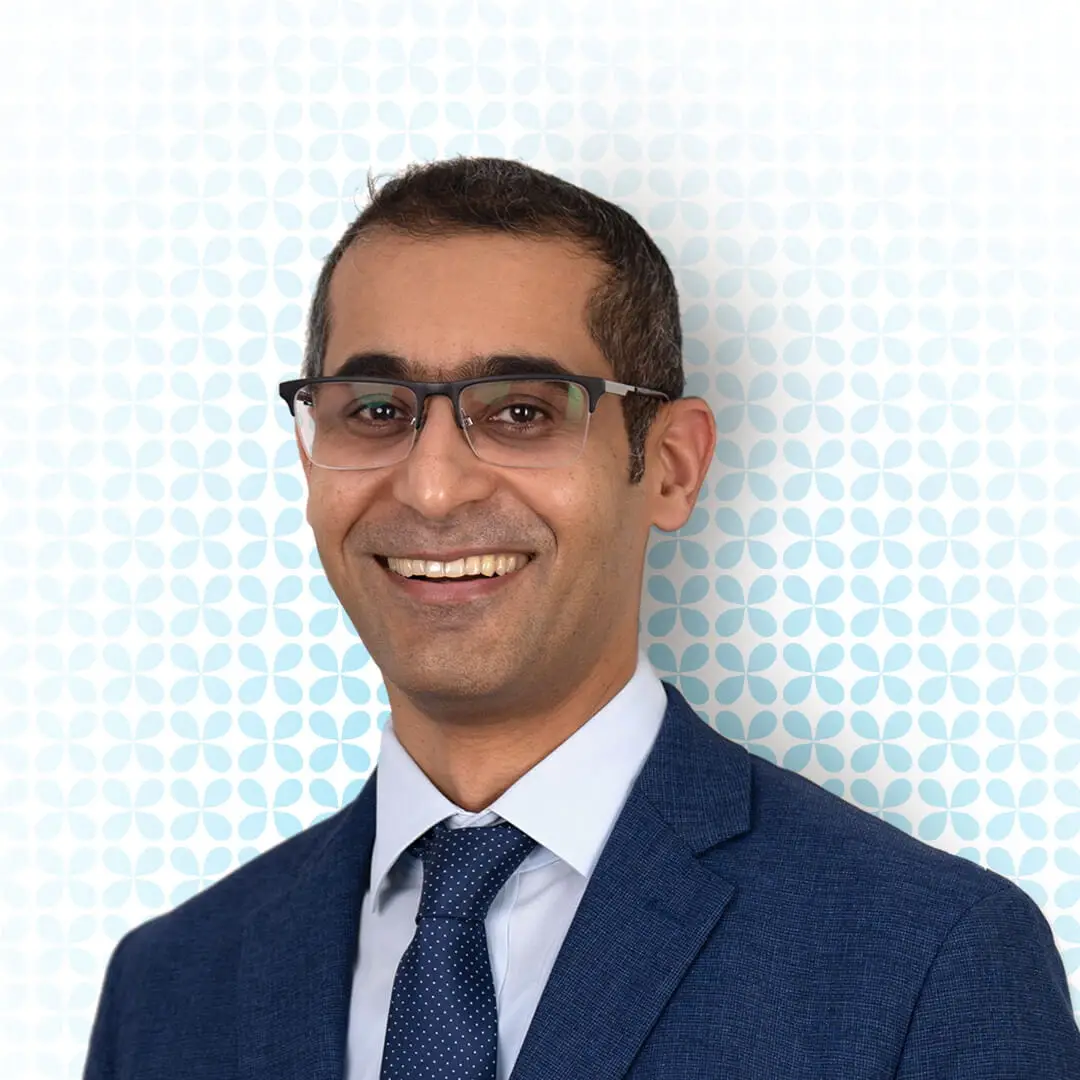
Dr. Salman Waqar
Consultant Ophthalmologist in adult and paediatric glaucoma and cataract surgeryAssociate Professor Of Ophthalmology (Adjunct)
GCAA Approved Specialist Aviation Medical Examiner
Dr. Salman Waqar is an experienced consultant ophthalmologist specialising in the treatment of adult and paediatric glaucoma and cataracts at Moorfields Eye Hospital Dubai in Dubai Healthcare City.
His areas of expertise include medical, laser and surgical treatments for glaucoma (including minimally invasive implants and aqueous shunt devices). He also offers cataract surgery using the latest small incision technology, and with a range of intraocular lenses (Toric, Multifocal and Extended Depth of Field), tailored to the patients individual needs.
Dr. Waqar graduated from Pakistan and has over 15 years’ experience of work in the United Kingdom. He holds a Certificate of Completion of Training from the UK, and is a Fellow of the Royal College of Ophthalmologists. He has worked in various prestigious eye units including the West of England Eye Unit (Exeter), where he completed his sub-specialty training in glaucoma. In his career, he has been appointed as a consultant across a wide range of leading medical institutions such as the Royal Eye Infirmary (Plymouth), Nuffield Health, Medical Eye Clinic and Newmedica. In addition to his clinical work, he has also performed with distinction as director of clinical governance and for the glaucoma service.
Dr. Waqar’s research interests include optimizing patient outcomes with minimally invasive surgery, using virtual reality simulation to investigate surgeon performance and the development of innovative surgical instruments to improve patient safety. He has published extensively in peer-reviewed journals, such as the British Journal of Ophthalmology and the Journal of Cataract and refractive Surgery, and presents regularly at national and international meetings.
He holds memberships with the United Kingdom and Eire Glaucoma Society, the European Society of Cataract and Refractive Surgeons and the American Academy of Ophthalmology.
In his capacity as an Honorary Fellow with Plymouth University, he has been involved in training the doctors and surgeons of our future. In 2019, his work was recognized with a nomination for a regional Trainer of the Year Award by the Peninsula School of Ophthalmology. In addition, he has been the recipient of numerous research grants, and has co-authored two medical textbooks. Other accolades include invitations as a surgical skills instructor at minimally invasive glaucoma surgery courses, and to the microsurgical skills course with the Royal College of Ophthalmologists.
In his spare time he is an avid reader, aspiring author and motivated triathlete.

Dr. Suhair Twaij
Consultant Ophthalmologist in Adult & Paediatric Strabismus Surgery, Paediatric Ophthalmology, Adult Cataract Surgery GCAA Approved Specialist Aviation Medical ExaminerDr. Suhair Twaij is a Consultant Ophthalmologist with a subspecialist interest in adult and paediatric Strabismus surgery, Paediatric Ophthalmology, adult Cataract Surgery and General Ophthalmology at Moorfields Eye Hospital Dubai.
Dr. Twaij recently relocated to the UAE from the UK, where she has worked as a consultant ophthalmologist at the Royal Victoria Hospital in Belfast since 2013. She was also the clinical lead for the adult motility service in Northern Ireland from 2014.
She holds a graduate degree in medicine from the Baghdad University Medical School, obtained in 1994.
Her areas of expertise include complex adult and paediatric squint surgery using the adjustable technique when needed, double vision correction, adult cataract surgery with an implant, Botox treatment for squints, double vision, blepharospasm and aesthetics.
She has over 20 years of experience in general ophthalmology, including cataract surgery, anterior and posterior segments such as glaucoma and diabetic retinopathy.
Dr. Suhair trained in the UK from 2004 in England and Northern Ireland and was awarded the certificate of completion of training (CCT) in ophthalmology in the UK in 2012. She was awarded the Royal College of Ophthalmologists Fellowship in the same year.
Throughout her career, she has practised in leading medical institutions such as The Royal Victoria Hospital in Belfast, Northern Ireland, Altnagelvin Area Hospital, Northern Ireland, The Bristol Eye Hospital, England, and King Hussein Medical City Amman, Jordan.
Dr. Suhair is an avid researcher and has Medline-published papers in various ophthalmology topics such as medical retina, paediatric ophthalmology and oculoplastics.
She is a member of the Royal College of Ophthalmologists, the British & Irish Paediatric Ophthalmology and Strabismus Association (BIPOSA) and the European Association of Strabismus (ESA).
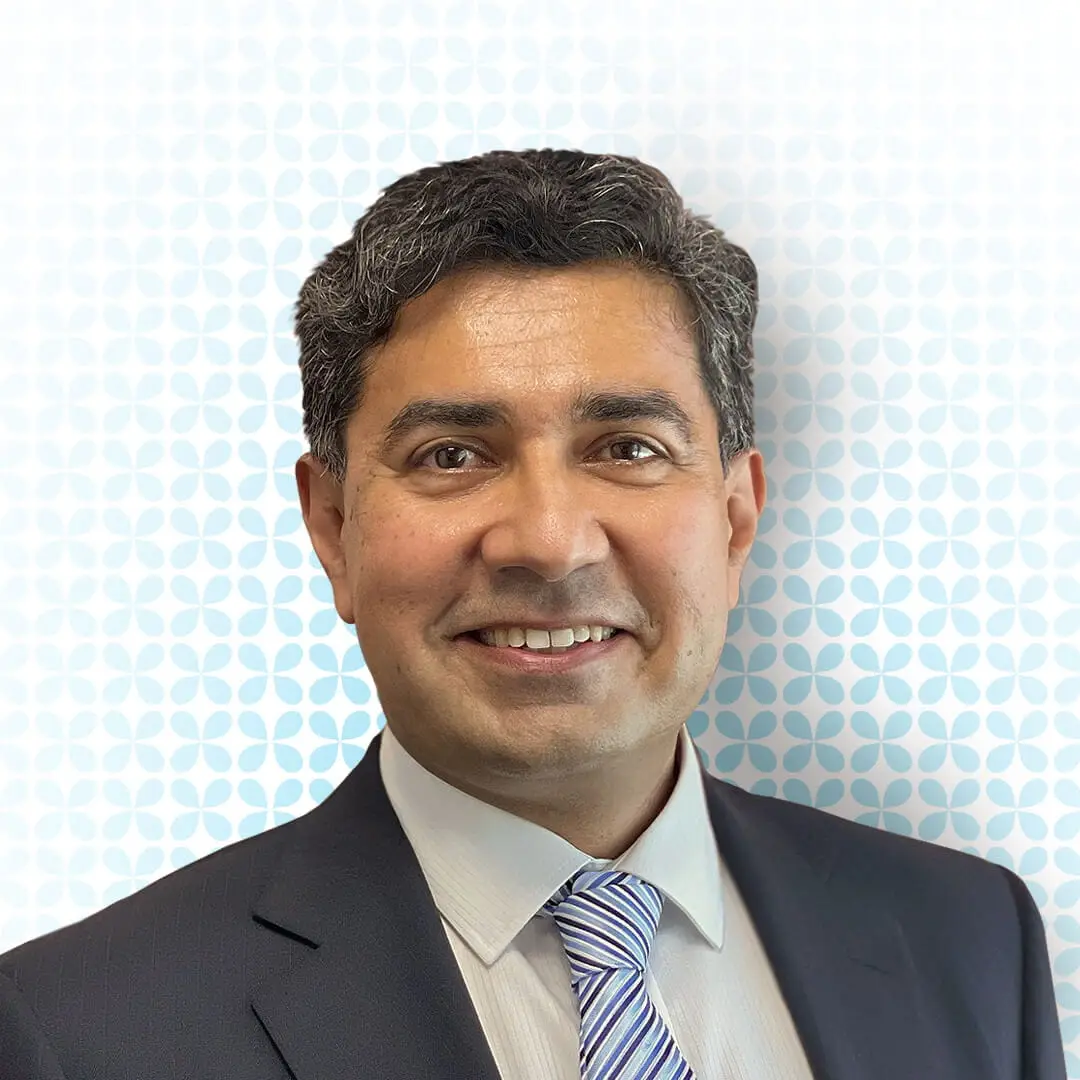
Dr. Syed M. Asad Ali
Consultant Ophthalmologist in Paediatric Ophthalmology and Strabismus and Cataract SurgerySyed Ali is a Consultant Paediatric Ophthalmologist with extensive experience in the management of all paediatric eye conditions including congenital eye diseases, paediatric cataracts, paediatric glaucoma, trauma and all types of squints in children and adults.
Syed works with advanced technology and techniques. He has over 10 years of extensive experience in screening and treating retinopathy of prematurity with retinal laser and intravitreal anti VEGF injection. He has wealth of experience in phacoemulsification procedures.
Syed Ali trained and has practiced in the UK and Pakistan and has over 18 years of experience in ophthalmology. After completing his basic specialist training, he undertook a fellowship in paediatric ophthalmology and ocular motility at the world renowned Wolverhampton Eye Infirmary, UK. His training in Pakistan and the UK is recognised by the General Medical Council (GMC) and was placed on specialist register.
In addition to his clinical experience, Syed has undertaken published original research and teaching in his specialist area, including as an assistant professor of ophthalmology at the Pakistan Institute of Ophthalmology.
He is a member of several professional bodies including The Royal College of Ophthalmologists, American Academy of Ophthalmology, The British Medical Association, Medical Defense Union and Royal College of Surgeons Edinburgh.

Dr. Irfan Khan
Consultant Ophthalmic surgeon in Paediatric Ophthalmology and adult StrabismusDr. Muhammad Irfan Khan is a highly experienced consultant Ophthalmic surgeon specialising in Paediatric Ophthalmology at Moorfields Eye Hospitals in Abu Dhabi and Dubai.
He earned three postgraduate degrees from the Royal College of Ophthalmologists London: DRCOphth, MRCOphth, and FRCOphth in 2013, along with a Paediatric Ophthalmology fellowship from the renowned Hospital for Sick Children, SickKids, Toronto, Canada.
With over 20 years of clinical and surgical experience, Dr. Irfan has practised in several countries, including Ireland, the United Kingdom, Canada, and the UAE. His career includes roles at institutions such as the Royal Victoria Eye and Ear Hospital in Dublin, Manchester Royal Eye Hospital, SickKids in Toronto, and Sheikh Khalifa Medical City in Abu Dhabi.
His subspecialty training includes managing complex paediatric eye conditions such as cataracts, glaucoma, and retinopathy of prematurity. He is also experienced in paediatric anterior segment reconstruction and common paediatric oculoplastics.
For adult patients, Dr. Irfan is particularly adept in performing adjustable suture squint surgeries, a technique that allows for precise postoperative alignment adjustments. This approach significantly improves outcomes for adults undergoing strabismus surgery, enhancing both visual function and cosmetic results.
He has undertaken research in the field of Ophthalmology and has published ten research papers and one book chapter in Childhood neurology.
He is a member of the Royal College of Ophthalmologists London and an International member of the American Association of Pediatric Ophthalmology and Strabismus. In 2015, he received the JD Moran Award from the Hospital of Sick Children in Toronto, Canada.

Dr. Ithar Alkheder
Specialist general OphthalmologistDr. Ithar Alkheder is a distinguished Specialist Ophthalmologist at Moorfields Eye Hospital Dubai, located in Dubai Healthcare City. His areas of expertise are general ophthalmology and comprehensive eye examinations.
He earned a Master’s degree in Ophthalmology and holds board certification from the Syrian Board Authority since 2011. His qualifications are further complemented by a Diploma in Pediatric Optics from Isabel University, Spain.
Dr. Alkheder brings over 13 years of regional and international experience, having practiced in several medical institutions both the UAE and Syria.
His research pursuits include corneal ulcer diagnosis and treatment at Aleppo Eye Surgery Hospital. He has published various research papgers in leading medical journals and presented in international ophthalmology conferences, focusing on penetrating glaucoma surgery, among other topics.
Dr. Alkheder is a member of the American Academy of Ophthalmology (AAO), the European Society of Retina (Euretina), and the International Society of Refractive Surgery (ISRS), reflecting his deep commitment to his field and continuous professional development.

Dr. Alaa Bou Ghannam
Visiting Specialist Ophthalmologist in Neuro-Ophthalmology, Paediatric Ophthalmology, Paediatric Glaucoma & Adult StrabismusDr. Alaa Bou Ghannam is a visiting specialist in neuro-ophthalmology, paediatric ophthalmology, and adult strabismus at Moorfields Eye Hospital Dubai in Dubai Healthcare City.
He holds a bachelor in science (2007) with high distinction and a medical degree (2011) from the American University of Beirut. He finished his ophthalmology residency at the American University of Beirut Medical Center in 2015 before pursuing a fellowship in pediatric ophthalmology and adult strabismus from Children’s National Health System and George Washington Hospital in Washington DC in 2016. He also finished another fellowship in neuro-ophthalmology from The University of Colorado in 2017.
He has over five years of regional/international experience in paediatric ophthalmology, adult strabismus, and neuro-ophthalmology in countries including Lebanon and The United States of America.
In his career, he has practiced in leading medical institutions such as The American University of Beirut Medical Center.
He has undertaken research in clinical ophthalmology and neurology and has published more than a dozen research papers and book chapters on strabismus, optic nerve diseases, paediatric glaucoma, paediatric ophthalmology, ocular electrophysiology, and nystagmus, in leading medical journals.
He is a member of the American Academy of Ophthalmology (AAO), Lebanese Ophthalmological Society (LOS), North American Neuro-ophthalmology Society (NANOS), and The American Association for Pediatric Ophthalmology and Strabismus (AAPOS).
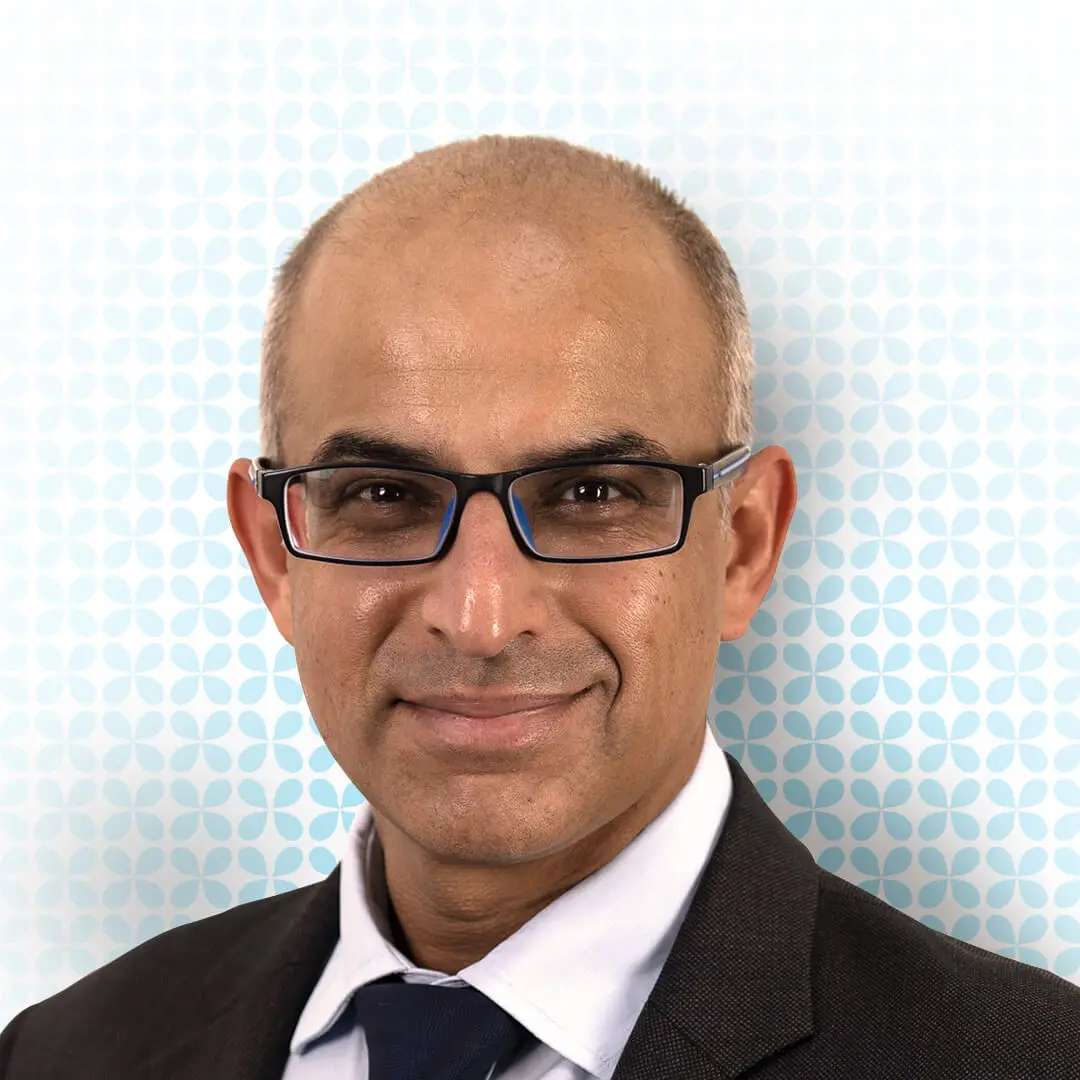
Dr. Avinash Gurbaxani
Visiting Consultant Ophthalmologist in Uveitis and Medical Retinal Diseases and Cataract SurgeryDr. Avinash Gurbaxani is a visiting Consultant Ophthalmologist, specialised in Uveitis, Medical Retina & Cataract surgery at Moorfields Eye Hospital Dubai in Dubai Healthcare City.
Dr. Avinash specialises in the assessment and management of uveitis and inflammatory eye disease (uveitis, infectious diseases, autoimmune diseases of the eye) as well as medical retinal disease, such as diabetes, macular degeneration and retinal vascular disease. He has broad experience in the diagnosis and management of complex inflammatory eye diseases, including the use of immunosuppression, as well as in treating retinal disease. Dr Gurbaxani is also skilled in managing complex cataract surgery associated with these diseases.
Dr. Avinash trained in ophthalmology in Oxford and London, working at The Oxford Eye Hospital in Oxford, Kings College Hospital, St. Thomas’ Hospital and Moorfields Eye Hospital in London. He has worked at the prestigious Medical Eye Unit in London as well as completing a Uveitis Fellowship and Medical Retina Fellowship at Moorfields London and the Sydney Eye Hospital in Australia, before returning to Moorfields London as a locum consultant.
Dr. Avinash is experienced in initiating research projects and running clinical trials, and has regularly published and presented papers at national and international conferences. He is a member of several professional bodies including the Royal College of Opthalmologists (RCOphth), Royal College of Surgeons of Edinburgh (RCS) (Ed), American Academy of Ophthalmology (AAO).

Dr. Christiane Al Haddad
Visiting Consultant Ophthalmologist in Paediatric Ophthalmology and Adult StrabismusDr Christiane Al- Haddad is a visiting associate professor of Ophthalmology, Specialised in Paediatric Ophthalmology and adult Strabismus at Moorfields Eye Hospital Dubai in Dubai Healthcare City.
She holds an MD degree from the American University of Beirut in 2000, an Ophthalmology degree from the American University of Beirut in 2004, a fellowship in paediatric ophthalmology from Children’s National Medical Center, Washington DC in 2005, and a fellowship in paediatric ophthalmology and adult strabismus from Duke Eye Center, Durham, North Carolina, USA in 2006.
Dr Al-Haddad has more than 15 years of regional/international experience in all aspects of Paediatric Ophthalmology and Strabismology in leading medical institutions: the American University of Beirut Medical Center (Lebanon), Children’s National Medical Center (USA) and Duke Eye Center (USA).
She has undertaken research in the field of Paediatric Ophthalmology & strabismus and has published more than 50 research papers on amblyopia, strabismus, genetic eye diseases, retinoblastoma, congenital glaucoma and eye tracking technology in leading journals including British Journal of Ophthalmology, American Journal of Ophthalmology, Journal of the American Association for Paediatric Ophthalmology and Strabismus, Journal of Paediatric Ophthalmology and Strabismus, and Canadian Journal of Ophthalmology among others.
Dr Al-Haddad is a member of the American Association for Paediatric Ophthalmology and Strabismus, the International Strabismological Association and the Costenbader Society. She is the director of the Paediatric Ophthalmology division in the Ophthalmology department at the American University of Beirut and established the retinoblastoma program with the oncology team at the Children’s Cancer Center in collaboration with St Jude Children’s Research Hospital, Memphis USA.
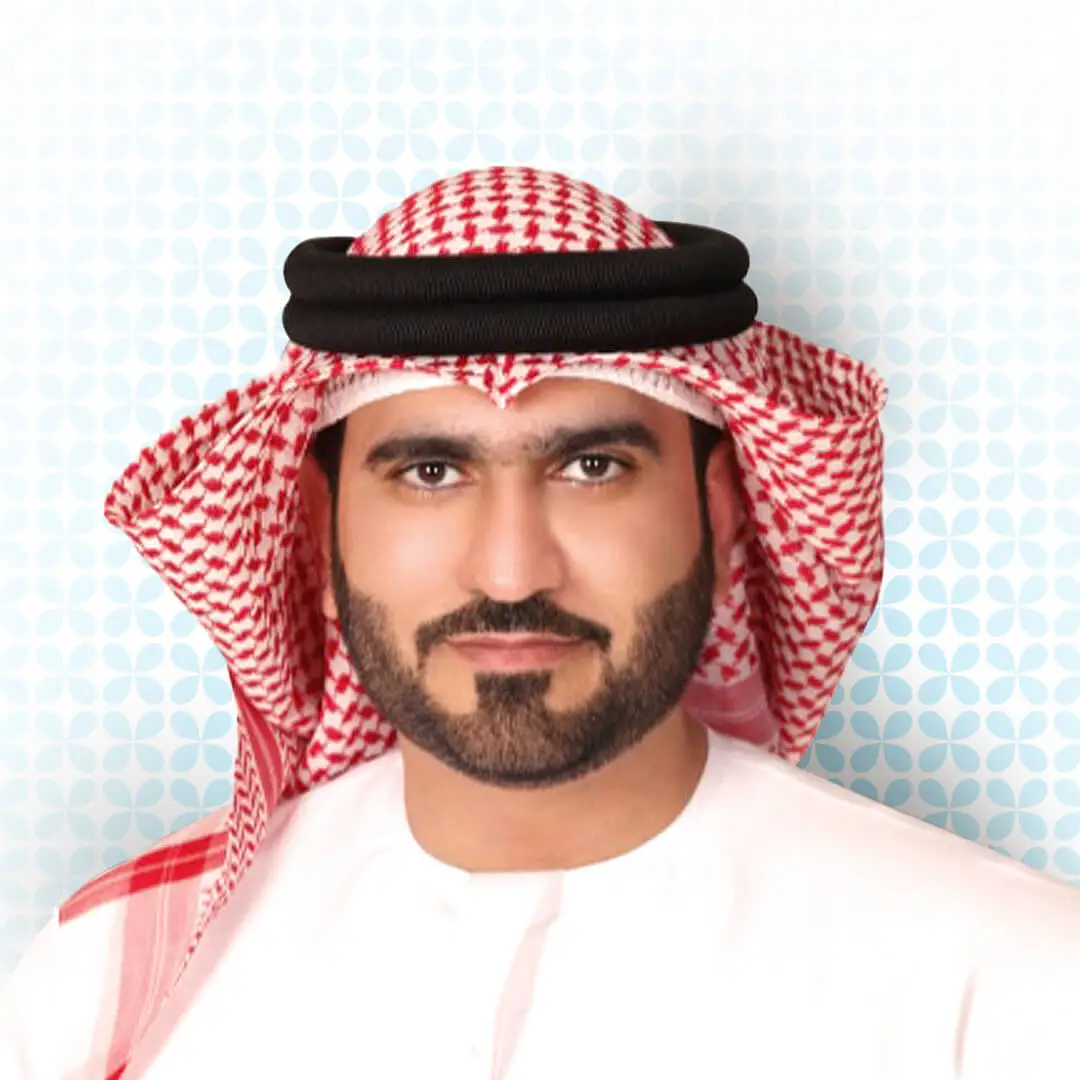
Dr. Khalid Alkhayat
Visiting Consultant Ophthalmologist in Oculoplastic SurgeryDr. Khalid Alkhayat is a Visiting Consultant Ophthalmologist, specialised in Oculoplastics at Moorfields Eye Hospital Dubai in Dubai Healthcare City.
He is a German Board Certified Ophthalmologist (Fachartz) and Fellow of the European Board of Ophthalmology (FEBO) since 2017.
Dr. Alkhayat has over 12 years of combined regional and international experience in Oculoplasty in countries including the UAE, Ireland and Germany.
During his career, he has practiced in leading medical institutions such as the Royal College of Surgeons in Ireland, Bruder Krankenhausin Trier, Germany, Gulf Medical University in Ajman, UAE, Dubai Hospital, UAE, Rashid Hospital, Dubai, UAE and Al Mafraq Hospital in Abu Dhabi, UAE.
He is also a member of Emirates Society of Ophthalmology (ESO).

Dr. Qasiem Nasser
Visiting Consultant Ophthalmologist in Oculoplastic SurgeryDr. Qasiem Nasser has dual Fellowship training in Oculoplastic Surgery and Cornea, Cataract and Anterior Segment Surgery. His area of expertise is in Ophthalmic Plastic and Reconstructive Surgery, including surgery on the eyelids, the orbit, and the tear drainage system for adults and children. In addition, he is also a specialist in Laser Assisted Cataract and Refractive Surgery, including LASIK, LASEK, Refractive Lens Exchange (RLE), Implantable Contact Lens (ICL) and Corneal Cross-Linking (CXL) for Keratoconus.
Dr. Nasser grew up in Amman, Jordan. He attended medical school at The Royal College of Surgeons in Ireland, after which he completed his Residency in Ophthalmology at The Royal Victoria Eye and Ear Hospital in Dublin. He then moved to the United States, where he completed a 2-year Ophthalmic Plastic and Orbital Reconstructive Surgery Fellowship at The University of Texas MD Anderson Cancer Center in Houston and Texas Oculoplastic Consultants in Austin. Dr. Nasser then persuaded another Fellowship in Cornea, Cataract and Anterior Segment Surgery at Moorfields Eye Hospital in London.
He is a member of the Royal College of Ophthalmologists in London and a Fellow of the Royal College of Surgeons in Edinburgh.
Dr. Nasser has been an active researcher and has published many manuscripts in peer-reviewed journals. In addition, he has given lectures at national and international meetings, including The American Society of Ophthalmic Plastic and Reconstructive Surgery, the American Academy of Ophthalmology and the World Ophthalmology Congress.

Dr. Rafic Antonios
Visiting Specialist Oculoplastic SurgeonDr. Rafic Antonios is a fellowship-trained Oculoplastic surgeon with expertise in reconstructive and cosmetic eye procedures involving the periocular area and pathologies involving the eyelid (Blepharoplasty), orbit, and lacrimal system at Moorfields Eye Hospital Dubai in Dubai Healthcare City.
He holds a Bachelor of Science (2008) with distinction and a Medical Degree (2012) from the American University of Beirut. He finished his ophthalmology residency at the American University of Beirut Medical Center in (2017) with induction to the Alpha Omega Alpha (AOA) – Honor Medical Society before pursuing a fellowship in Oculoplastics and Reconstructive Surgery and an additional fellowship in craniomaxillofacial trauma at the University of Montreal, Canada (2019).
He has over five years of regional and international experience in ophthalmic plastic and reconstructive surgery in Canada and Lebanon.
Dr. Rafic has practised in leading medical institutions such as Saint Justine Children’s Hospital, Maisonneuve-Rosemont Hospital, Sacre-Coeur Hospital in Canada, and the Beirut Eye & ENT Specialist Hospital in Lebanon.
He has 28 publications in his field in peer-reviewed journals and several posters and presentations at national and international conferences.
He is a member of the Alpha Omega Alpha (AOA) Medical Honor Society and the Lebanese Society of Ophthalmology (LOS).

Dr. Rola Ba-Abbad
Visiting Consultant Ophthalmologist Specialised in Genetic Eye Diseases and Medical RetinaRola Ba-Abbad is a Consultant Ophthalmologist in genetic eye disease, including inherited retinal disorders for adults and children, and medical retina at Moorfields Eye Hospital Dubai in Dubai Healthcare City.
She holds a PhD from University College London, 2018, and is a Fellow of the Royal College of Physicians and Surgeons of Glasgow since 2011. She earned her bachelor’s degree (MBBS) in Medicine and Surgery from King Saud University and successfully completed her specialist training at King Khaled Eye Specialist Hospital and affiliated hospitals in Riyadh in 2006.
She has more than 10 years of regional and international experience in medical retina, electrophysiology and inherited retinal disorders in countries including Saudi Arabia, the United Kingdom and Canada.
In her career, she has practised in leading medical institutions such as Moorfields Eye Hospital in London, Hospital for Sick Children in Toronto, and King Khaled Eye Specialist Hospital.
She has undertaken research in inherited retinal disorders, visual neuroscience-clinical psychophysics, and electrophysiology of vision and has published several research papers on retinal and corneal disorders in leading journals such as Ophthalmology and Investigative Ophthalmology and Visual Sciences, among others.
She is a member of The Association for Research in Vision and Ophthalmology and is the recipient of the Foundation Fighting Blindness: Diana Davis Spencer Clinical Research Fellowship Award in 2018.

Dr. Wajiha Kheir
Visiting Consultant Ophthalmologist in Medical Retina and Ocular OncologyDr. Wajiha Kheir is a visiting Assistant Professor of Ophthalmology and Consultant Ophthalmologist, specialised in Medical Retina and Ocular Oncology at Moorfields Eye Hospital Dubai in Dubai Healthcare City.
Dr. Wajiha completed her undergraduate studies and medical education at the American University of Beirut, Lebanon. She was awarded the BSc degree in Biology (2009) with high distinction and the Penrose Award, and the MD degree (2013) with induction to the Alpha Omega Alpha (AOA) – Honor Medical Society. She then completed a year of Internal medicine Internship followed by three years of Ophthalmology residency at the American University of Beirut Medical Center (2017). Her subsequent sub-specialty training includes one year of Medical Retina fellowship and one year of Ocular Oncology with Clinical Pathology Concentration fellowship, both at the Duke Eye Center, Duke University School of Medicine.
She has more than five years of regional and international experience in Medical Retinal and Ocular Oncology in the United States and Lebanon. In her career, she has practiced in leading medical institutions such as Duke University Health System and the American University of Beirut Medical Center.
Dr. Wajiha has eighteen peer-reviewed journal articles and 10 book chapters published. To date, her research work has been presented in over twenty posters and/or paper presentations at regional and international conferences. Her research interests relate to age-related macular degeneration, ophthalmic oncology, radiation retinopathy as well as retinal degenerations and electrophysiology of vision.
She is a member of the AOA Medical Honor Society, the American Academy of Ophthalmology, the American Society of Retinal Specialists and the International Society of Ocular Oncology.
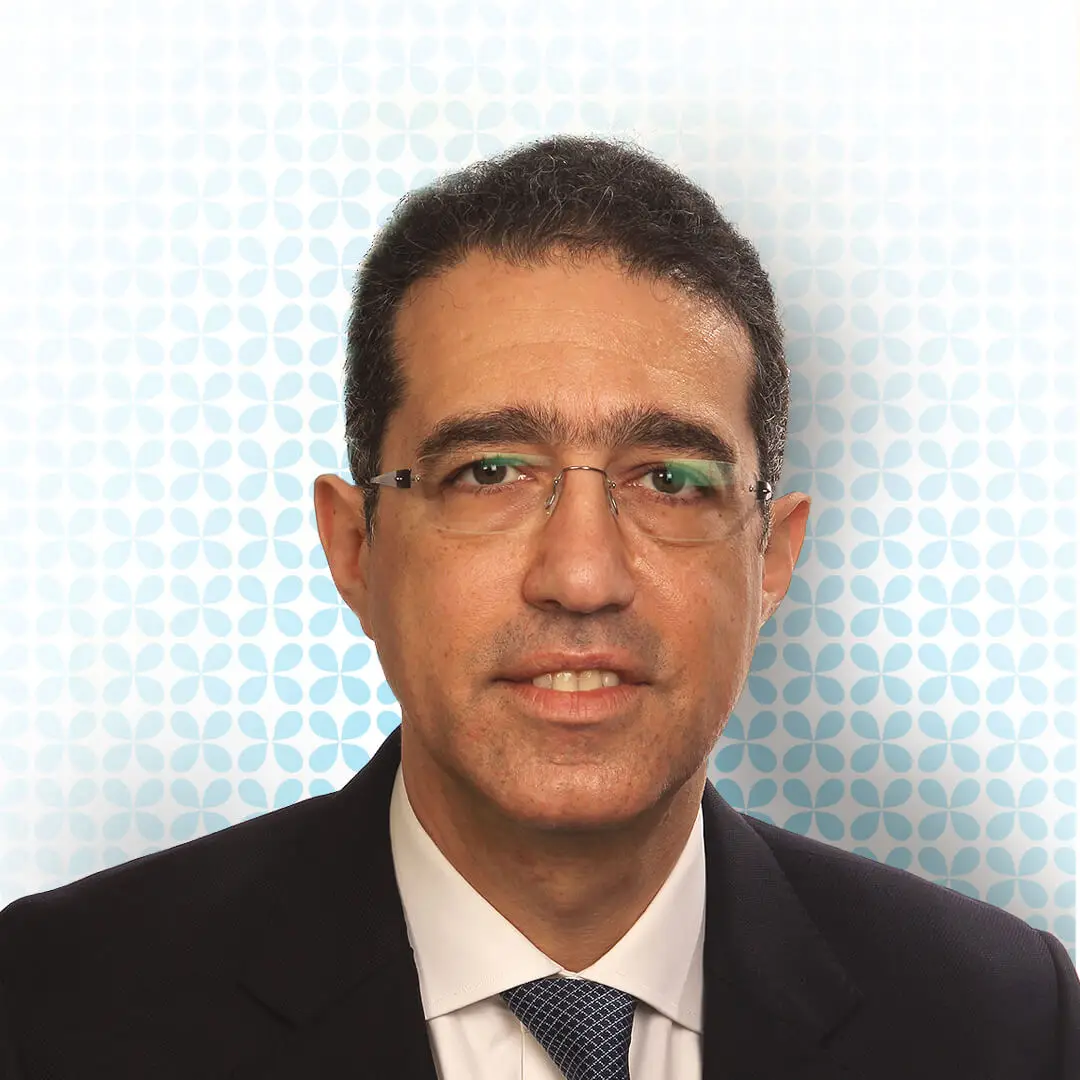
Prof. Ziad Bashshur
Visiting Consultant Ophthalmologist in Medical & Surgical RetinaDr. Ziad Bashshur is a visiting Ophthalmologist specialising in Medical and Surgical Retina at Moorfields Eye Hospital Dubai in Dubai Healthcare City.
He holds a Doctor of Medicine Diploma from the American University of Beirut (AUB) in 1994. He has also completed an internship in internal medicine at Georgetown/VA medical center (1994-1995) followed by ophthalmology residency training at AUB (1995-1998) and a vitreoretinal fellowship at the University of Virginia, USA.
He has more than 22 years of regional/international experience in vitreoretinal diseases and surgery in countries including United States and Lebanon.
In his career, he has practiced in leading medical institutions such as American University of Beirut in Lebanon and University of Virginia in the US.
He is currently a tenured professor and vice-chairman of Ophthalmology at the American University of Beirut.
Dr. Bashshur has undertaken research in retinal diseases and has published over 50 research papers on macular degeneration, diabetic retinopathy, vascular diseases of the retina and retinal imaging in leading journals. In addition, he sits on several advisory boards within the medical industry.
He regularly speaks at professional meetings worldwide and serves on the review board of several renowned peer-reviewed ophthalmology journals.
He is a member of the American Society of Retina Specialists (ASRS), Retina Society and Alpha Omega Alpha Honor Society

Dr. Ziad Khoueir
Visiting Consultant Ophthalmologist in Adult Glaucoma and Cataract surgeryDr. Ziad Khoueir is a visiting Consultant ophthalmologist specialising in adult glaucoma and cataract surgery at Moorfields Eye Hospital Dubai in Dubai Healthcare City.
He holds a medical degree from the Saint-Joseph University in Beirut, Lebanon (2008) and completed his ophthalmology residency at the Hotel-Dieu de France Hospital (2013). He then completed postdoctoral clinical and research fellowships at the Glaucoma Institute, UPMC-Sorbonne University in Paris, France (2014) and at the Massachusetts Eye and Ear Infirmary, Harvard Medical School in Boston, USA (2016). He is also a laureate of the Glaucoma Subspecialty Diploma of the European Board of Ophthalmology.
He has more than seven years of both regional and international experience in glaucoma, one during which he has practised clinical and research work in leading medical institutions such as the Glaucoma Institute at the Paris Saint-Joseph Hospital (France), the Massachusetts Eye and Ear Infirmary (USA), the Beirut Eye & ENT Specialist Hospital (Lebanon) and the Muscat Eye Laser Center (Oman).
Dr. Ziad currently holds the position of associate director of the Glaucoma division at the Beirut Eye and ENT Specialist Hospital. He is a clinical instructor and lecturer at the Saint-Joseph University Medical School in Beirut, Lebanon.
His research focuses on innovative techniques in managing and diagnosing glaucoma, such as minimally invasive glaucoma surgery (MIGS), glaucoma lasers and the use of Optical Coherence Tomography imaging in glaucoma. He has published more than 35 research papers and chapters on those topics in leading ophthalmology journals. He has been invited to lecture and present his work in regional and international meetings in more than 20 countries over the last few years. He is currently a research collaborator at the Mayo Clinic Ophthalmology Department in Jacksonville, Florida, USA.
He is the co-chair of the associate advisory board of the World Glaucoma Association and a member of the associate advisory board of the International Society of Glaucoma Surgery.

Dr. Aseel Ghanem
Consultant Ophthalmologist in Medical RetinaDr. Aseel Ghanem is a Consultant Ophthalmologist at Moorfields Eye Hospital Abu Dhabi and Imperial College London Diabetes Centre (ICLDC) with more than 8 years of experience. She is experienced in refractive surgeries, medical retina, lacrimal surgeries, pterygium excision with graft, squint surgery, eyelid laceration repair & more.
She completed her medical degree from Mutah University, Jordan in 2012 and completed her residency from Ibn Al Haytham Hospital, Jordan. She is a fellow of International Council of Ophthalmology.

Dr . Usman Mahmood
Consultant, Ophthalmologist Specializes in Retina and Cataract SurgeryDr. Usman Mahmood is a Consultant Ophthalmologist with extensive experience in vitreoretinal surgery, sutureless advanced cataract surgery, advanced Diabetic retinopathy, retinal detachment repairs, macular holes, epiretinal membranes and ocular trauma involving posterior segment.
Dr. Usman is a fellow in FRCS (Ophthalmology) Royal college of Surgeons Edinburgh UK, FRCS (Ophthalmology) Royal College of Surgeons and Physicians of Glasgow UK, MRCOphth Royal College of Ophthalmologists London UK. He obtained Certificate of Specialist training in Ophthalmic Surgery from Royal College of surgeons in Ireland. He is a fellow in Vitreoretinal Surgery from Manchester Royal Eye Hospital, Manchester, UK.
Dr. Usman is also a member European Society of Vitreoretinal Surgeons and a Life member of Ophthalmic Society of Pakistan.

Dr. Omar Rafiq
Consultant, Ophthalmologist Specializing in small incision cataract surgery (phacoemulsification) and advanced glaucoma surgeryDr. Omar Rafiq is a Consultant Ophthalmologist specializing in small incision cataract surgery (phacoemulsification) and advanced glaucoma surgery including MIGS ( Minimally Invasive Glaucoma Surgery ). He has performed over 10,000 surgical procedures.
Dr. Omar is a graduate of the University of Leeds Medical School – obtaining his MBChB, from the United Kingdom. He is a Fellow of the Royal College of Ophthalmologists – UK (FRCOphth) and holds a Certificate of Completion of Training (CCT) and is on the General Medical Council Specialist Register for Ophthalmology. Following the CCT, he completed an advanced fellowship in glaucoma and complex cataract at the Western Eye Hospital in London. He also completed his Postgraduate Diploma in Cataract and Refractive Surgery from the University of Ulster with a Distinction grade. He has more than 15 years of experience in the United Kingdom and the United Arab Emirates. Among many other experiences, he was the youngest Director of the NSPCC at a regional level from 1998 to 2000 and a Special Constable Police Officer with South Yorkshire Police from 2000 to 2005.
He has done a great deal of research, clinical trials, published and lectured on his areas of expertise.
What our patients say about us
Blogs
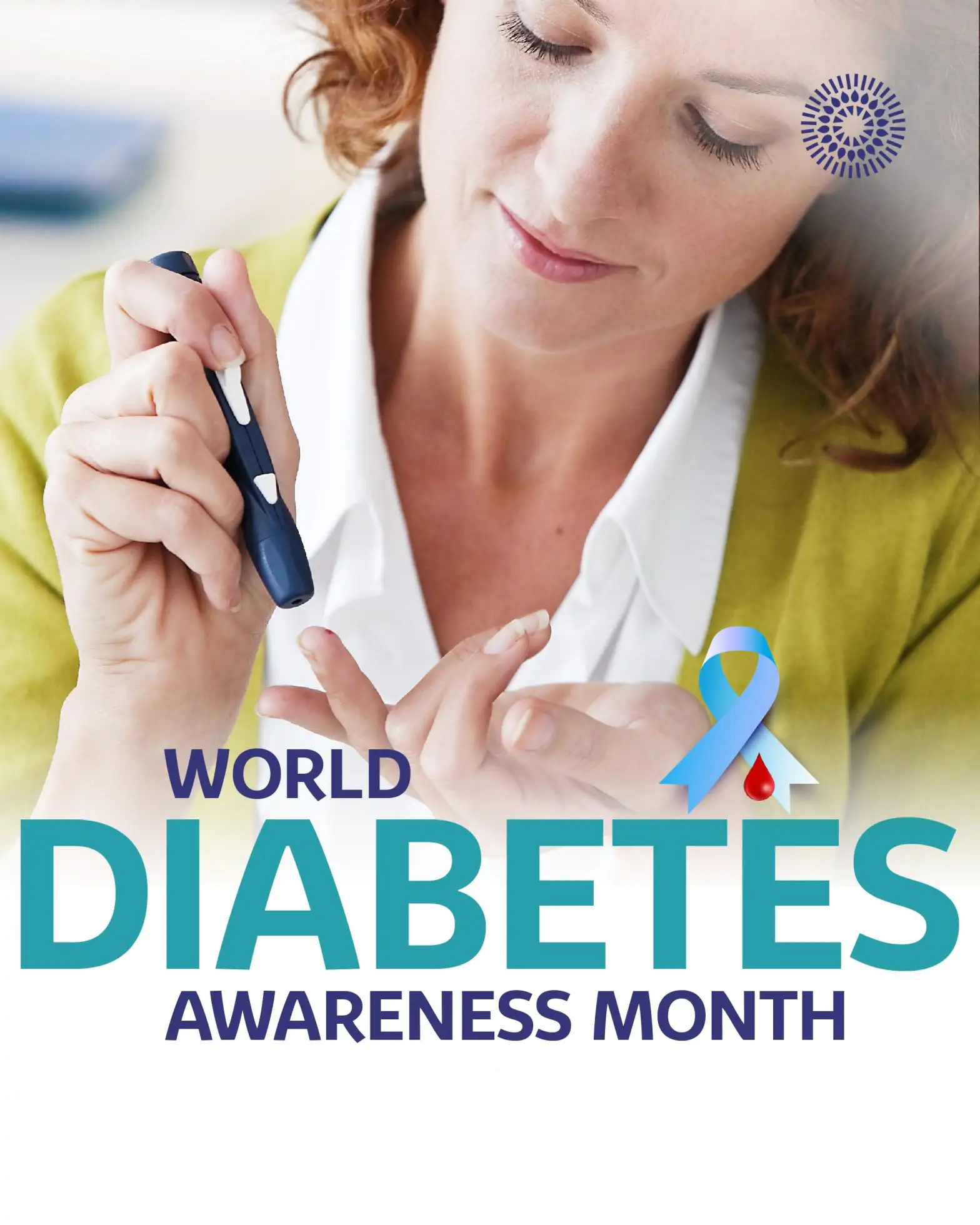
Every November, Diabetes Awareness Month reminds us that awareness and early prevention can make a lasting difference in living well with diabetes. This year’s World Diabetes Day theme, “Know More, Do More for Diabetes at Work,” highlights how diabetes management extends beyond medical care, shaping our everyday habits, especially in the workplace.
For many people working in Dubai and across the UAE, where long hours and digital screen use are common, understanding how diabetes affects eye health is essential to maintaining well-being and productivity.
This blog explores the connection between diabetes and vision, early signs to watch for, and simple lifestyle choices that can help protect your eyesight, at work and beyond.
Facts about diabetes
According to the International Diabetes Federation (IDF), an estimated 589 million adults worldwide are currently living with diabetes, and the number is projected to reach 853 million by 2050. This global rise reflects changing lifestyles, dietary habits, and reduced physical activity, all contributing to the growing public health challenge of diabetes.
In the United Arab Emirates, around 20.7% of adults aged 20 and above, equivalent to roughly 1.3 million people, are living with diabetes, and this is projected to increase, reaching approximately 23% of the population by 2050 (International Diabetes Federation)
These figures highlight the urgency of early detection and ongoing management to reduce health complications and protect long-term vision and overall well-being.
Diabetes and the working population
According to the International Diabetes Federation, 7 in 10 people living with diabetes are of working age (20–64 years). Maintaining healthy vision can be challenging for busy professionals in the UAE, where modern work often involves long hours at the workplace, extended screen time, and imbalanced diet.
Fluctuating glucose levels can temporarily blur vision, making it difficult to focus, read, or drive. Over time, inconsistent control can damage the retina, impacting vision and workplace performance.
Recognising early signs and adopting preventive habits can help you maintain sharper, more comfortable vision and ensuring that diabetes does not stand in the way of a productive working life.
The link between diabetes and vision
While diabetes is well known for affecting overall health, many people are unaware of its impact on the eyes. Over time, persistently high blood sugar levels can damage the blood vessels in the retina, the light-sensitive tissue at the back of the eye, leading to diabetic retinopathy, one of the leading causes of preventable sight loss worldwide.
The scale of this impact is significant, with the International Agency for the Prevention of Blindness (IAPB) reporting that around one in three people living with diabetes will experience vision complications during their lifetime, and one in ten will develop vision-threatening conditions such as proliferative retinopathy or diabetic macular oedema.
Beyond diabetic retinopathy, diabetes can also increase the risk of other eye conditions, including:
- Cataracts, a condition that causes cloudy or blurred vision and tends to develop earlier in people with diabetes.
- Glaucoma, a group of eye diseases that damage the optic nerve, often without noticeable initial symptoms, can lead to irreversible vision loss.
These conditions often progress silently in their early stages, meaning vision changes may only become apparent once the disease has advanced. Early warning signs can include blurred or fluctuating vision, poor night vision, or seeing dark spots, which should never be ignored. The most effective way to protect eyesight is through regular, comprehensive eye examinations, which enable ophthalmologists to detect early changes and manage complications before they affect sight.
Therefore, understanding these risks is the first step towards prevention, especially for those balancing demanding work schedules and daily routines that can make it challenging to prioritise regular eye care.
Eye health and well-being at work
Managing diabetes at work requires adopting habits that support long-term health. These include:
Eat balanced, low-glycaemic meals:
Choose foods that stabilise blood sugar, such as whole grains, vegetables, lean proteins, and low-glycaemic options, which provide steady energy and reduce sugar spikes. Keep eye-friendly snacks like nuts, fruit, and carrot sticks nearby as they contain vitamins E and A, which are beneficial for eye health.
Stay hydrated
Dehydration can raise blood sugar levels and worsen dry eyes, a common complaint among office workers in Dubai due to highly air-conditioned indoor spaces. Always have a bottle of water and drink regularly throughout the day.
Monitor blood pressure and cholesterol.
Both high blood pressure and elevated cholesterol can accelerate the progression of diabetes-related eye disease. Staying physically active, managing stress, and following your doctor’s recommendations all play a vital role in protecting long-term eye health and preventing complications.
Move regularly
Short, frequent breaks throughout the day help regulate blood sugar, improve circulation, and ease muscle tension. Even brief stretches or short walks during work can make a meaningful difference to overall wellbeing and give your eyes a chance to rest, reducing visual fatigue from prolonged screen time.
Schedule regular eye checks.
An annual comprehensive eye examination is one of the most effective ways to protect your sight. Modern retinal imaging enables ophthalmologists to identify very early changes in the eye, often before any symptoms appear, so they can intervene promptly, prevent further damage, and tailor a treatment plan to your individual needs.
The power of awareness and prevention
According to the International Diabetes Foundation and IAPB, up to 95 per cent of vision loss caused by diabetic retinopathy can be prevented through early detection and timely treatment. Eye screenings should be part of every diabetes care routine, even when vision feels normal.
Prevention always remains the best approach, and consistent blood-sugar control, balanced nutrition, and regular medical follow-up significantly reduce the risk of vision-related complications.
To learn more about diabetic retinopathy, including symptoms, causes, and treatment options, visit https://moorfields.ae/service/retina/diabetic-retinopathy/
Frequently Asked Questions
How often should people with diabetes have an eye exam?
People with diabetes should undergo a comprehensive eye examination at least once every 12 months, even if their vision seems stable. During this exam, the ophthalmologist will assess the retina, optic nerve, and blood vessels using advanced imaging techniques to detect early invisible changes to the naked eye.
Those who already show early signs of diabetic retinopathy or macular changes may be advised to attend check-ups more frequently, sometimes every six months or as their specialist recommends. Regular screening ensures that any progression of eye disease can be managed promptly, significantly reducing the risk of vision loss.
What are the early signs of diabetic eye disease?
In its early stages, diabetic eye disease often develops silently, without noticeable symptoms. However, as the condition progresses, warning signs may include:
- Blurred or fluctuating vision that comes and goes.
- Dark spots, floaters, or shadows in your field of vision.
- Reduced night or colour vision.
- Difficulty focusing on near or distant objects.
Any sudden change in vision should be considered a warning sign. Seeking prompt evaluation from an eye specialist can help detect whether these changes are linked to diabetic retinopathy, cataracts, or another underlying issue. Early diagnosis allows for timely treatment before permanent damage occurs.
Can stable blood sugar really prevent eye disease?
Yes. Keeping blood sugar levels within a healthy range is one of the most effective ways to protect your eyes. Stable blood glucose, blood pressure, and cholesterol help maintain the health of the tiny blood vessels that nourish the retina.
Fluctuating or consistently high blood sugar can cause these vessels to swell, leak, or close off, leading to diabetic retinopathy. Over time, this may result in blurred vision or vision loss. By following a balanced diet, taking prescribed medication, exercising regularly, and monitoring blood glucose as advised by your doctor, you can significantly reduce the risk of developing sight-threatening complications such as diabetic retinopathy and cataracts.
Is vision loss from diabetes reversible?
The reversibility of vision loss depends on how early the condition is detected and treated. In its early stages, diabetic eye disease can often be managed successfully, with treatments such as laser therapy or intravitreal injections helping to stabilise or even improve vision.
However, the vision loss may become irreversible if the disease progresses to an advanced stage where significant damage has occurred (particularly to the retina or optic nerve). This is why early detection through regular eye screenings is so vital. Preventive care, timely diagnosis, and adherence to treatment plans offer the best chance of preserving clear sight for the long term.
How can workplaces support employees with diabetes?
Workplaces play a key role in supporting employees with chronic health conditions such as diabetes. A health-conscious environment can help individuals manage their conditions effectively while maintaining productivity.
Employers can:
- Encourage healthy meal and snack options in cafeterias or vending areas.
- Allow flexible scheduling for medical appointments or eye check-ups.
- Promote regular breaks during long periods of screen use to reduce eye strain and regulate blood sugar.
- Offer wellness initiatives that include diabetes awareness sessions or vision screening days.
Such measures not only support employees’ wellbeing but also improve morale, reduce absenteeism, and enhance overall workplace efficiency. A culture that values health ultimately benefits both staff and organisation alike

Every October, the world comes together to mark World Sight Day, a global initiative led by the International Agency for the Prevention of Blindness (IAPB) to raise awareness about the importance of eye health. World Sight Day falls on 9 October this year under the global overarching theme “Love Your Eyes.”
This year, the focus is “Love Your Eyes at Work,” highlighting that protecting our vision is essential for personal well-being, productivity, and safety in the workplace.
Whether you spend your day in front of a computer, driving long distances, teaching, or working outdoors, your eyes are constantly at work. Yet, they are often overlooked in workplace health and wellness conversations.
In this blog, we highlight important facts, the importance of eye health in the workplace, the risks you may face, and practical steps to protect your sight for years to come.
General facts about vision and eye health
Globally, at least 2.2 billion people have near or distance vision impairment, and in at least 1 billion of these cases, the impairment could have been prevented or is yet to be addressed (World Health Organisation). The leading causes of vision impairment and blindness are:
The encouraging news is that 90% of all sight loss is preventable or treatable (IAPB). With early detection, most eye diseases can be managed, treated, or their progression slowed.
The importance of eye health at work
Vision problems affect overall quality of life, from daily comfort to productivity, concentration, and safety at work. In 2020, an estimated 143 million working-age adults had moderate or severe vision impairment.
- Good vision improves productivity by 22%. Something as simple as wearing the correct spectacles can significantly enhance work performance.
- Even mild vision impairment can reduce productivity by 10% and accuracy by 22%.
In Dubai and across the UAE, where long working hours, screen-based jobs, and exposure to dust, air conditioning, and intense sunlight are common, protecting eye health in the workplace is more important than ever.
Common workplace eye health issues and solutions
Digital eye strain and dry eyes
Many professionals in the UAE spend 6–10 hours daily on digital devices, which can lead to digital eye strain, blurred vision, headaches, and tired eyes.
Another common issue is dry eye, which occurs because we blink less when using screens, combined with the effects of air-conditioned indoor environments and the region’s hot climate.
Tips to reduce strain and dryness:
- Follow the 20-20-20 rule – every 20 minutes, look at something 20 feet away for at least 20 seconds.
- Use lubricating drops if advised by an eye specialist.
- Stay hydrated and ensure healthy humidity levels indoors.
- Prioritise rest and adequate sleep, as fatigue can worsen digital strain.
The five-minute check
Simple adjustments at your desk can make a big difference. Use this quick Five-Minute Check (IAPB) to optimise your workspace and protect your eyes while working at a screen.
- My chair supports my entire body, and my feet are adequately rested on the floor.
- My monitor is slightly below eye level, helping my eyes to look downward. Note that the recommended placement is 15–20 degrees below eye level.
- My screen is 50–66 cm away from my eyes.
- My screen can tilt and swivel and has inbuilt glare filters.
- My screen is tilted 10° to 20° away from me.
- My screen is positioned away from glare of any lighting or windows.
- My room is well lit.
- My screen is dust free.
- My blue light glasses are within reach.
- I have increased fonts and zoomed in to avoid bending or moving closer to my screen.
Nutrition and healthy eating at work
Eye health starts from within and a diet rich in antioxidants, vitamins, and omega-3 fatty acids can help reduce the risk of age-related eye conditions.
Smart workplace choices:
- Snack on carrots, cucumbers, nuts, and seeds instead of processed foods.
- Add green leafy vegetables, citrus fruits, and oily fish such as salmon to meals.
- Limit excess sugar and refined carbs, particularly if you have diabetes
Protecting your eyes in different work environments
Office workers
- Use the 5-minute checklist.
- Apply the 20-20-20 rule.
- Ensure pro-per lighting to reduce glare.
Outdoor workers
- Wear 100% UV-blocking sunglasses.
- Use protective eyewear against dust, chemicals, or construction debris.
- Take breaks in shaded areas to reduce glare and dryness.
Drivers and pilots
- Keep windscreens clean to minimise glare.
- Divert air conditioning away from blowing directly into your eyes
- Regularly update your prescription glasses or lenses.
- Avoid driving with untreated cataracts, which cause halos and blur.
How to “Love Your Eyes at Work” every day
Building small, consistent habits into your daily routine can help you look after your eyes. Regular eye checks are one of the most important steps you can take.
- Schedule regular eye checks – Early detection of cataract, glaucoma, or diabetic eye disease is crucial in preserving vision.
- Consult a specialist early – Do not ignore redness, discomfort, or blurred vision.
- Follow advice – Apply the steps highlighted to maintain proper eye health.
Eye health is essential for work and life
World Sight Day 2025 calls us to “Love Your Eyes at Work.” Vision is one of our most valuable assets, shaping how we learn, connect, and thrive professionally and personally. By taking proactive steps, you can protect your vision well into the future.
If you are due for an eye check or have noticed any changes in your vision, ensure to take action.
Frequently Asked Questions
How often should i get my eyes checked?
For most adults, a comprehensive eye examination every one to two years is sufficient to maintain healthy vision. However, if your job requires prolonged computer use or you spend much of the day on digital devices, more frequent checks may be beneficial.
Regular eye tests are not just about updating your glasses prescription. They allow ophthalmologists to detect early signs of eye conditions such as glaucoma, cataracts, or retinal disease, many of which may not show obvious symptoms in their initial stages. For individuals living with diabetes, annual eye examinations are essential, as changes to the retina can occur silently and only be detected through professional assessment.
Are dry eyes a serious condition or just a minor discomfort?
Dry eyes are often underestimated as a simple irritation, but they can significantly affect daily comfort, productivity, and even long-term vision. The condition occurs when the eyes do not produce enough tears or when tears evaporate too quickly, often due to prolonged screen use, air-conditioned offices, or environmental factors such as dust and heat.
If left untreated, chronic dry eye can cause inflammation, blurred vision, difficulty focusing, and, in severe cases, damage to the corneal surface. This can interfere with daily tasks, including reading, driving, and computer work.
Dry eye can usually be managed effectively with lifestyle changes, artificial tears, and, when necessary, advanced clinical treatments. Seeking advice early makes a significant difference, helping you maintain comfort at work and avoid complications later in life.
Can workplace habits really affect the development of cataracts?
Cataracts develop naturally with age, but certain lifestyle and occupational factors can influence how quickly they progress. Prolonged exposure to UV light, common among outdoor workers in the UAE, can accelerate cataract formation. Similarly, poor dietary habits, smoking, and not wearing protective eyewear in hazardous environments may also contribute.
Symptoms of cataracts include blurred or cloudy vision, difficulty seeing in low light, or glare around lights, all of which can make workplace tasks more challenging. By protecting your eyes with UV-blocking sunglasses, maintaining a healthy lifestyle, and attending routine eye examinations, you can slow the progression of cataracts and ensure timely treatment if they develop
What is the link between diabetes and vision at work?
Diabetes is one of the leading causes of preventable vision loss worldwide. High blood sugar levels can damage the delicate blood vessels in the retina, leading to a condition called diabetic retinopathy. In its early stages, this condition is usually silent, showing no obvious symptoms. By the time vision changes are noticed, damage may already be advanced.
For working professionals in Dubai and the wider UAE where the prevalence of diabetes is among the highest globally, this poses a significant risk. Reduced vision can impact work performance, safety, and independence.
The most effective protection is regular diabetic eye screening, combined with good blood sugar, blood pressure, and cholesterol control. Early detection allows for treatment options, such as laser therapy or advanced medications, which can preserve sight and help individuals continue performing effectively at work.
What foods should I keep at my desk for healthy eyes?
Nutrition plays a surprisingly powerful role in protecting your eyes at work. Keeping the right snacks at your desk can support eye health, improve concentration, and reduce fatigue.
- Nuts and seeds (such as almonds, walnuts, and sunflower seeds) provide vitamin E and omega-3 fatty acids, which help protect against age-related macular degeneration and dry eyes.
- Fresh fruit such as oranges, berries, and kiwi are rich in vitamin C, an antioxidant that supports the health of blood vessels in the eye.
- Vegetables like carrots, cucumbers, and bell peppers contain beta-carotene and other essential nutrients that contribute to retinal health.
- Fatty fish (ideal for lunch rather than a snack) such as salmon or sardines provide high levels of omega-3, which supports tear film stability and reduces the risk of dry eyes.
By choosing these healthy snacks instead of processed foods high in sugar and refined carbohydrates, you can give your eyes the nutrients they need to perform well throughout the day and safeguard your long-term vision

As the new school year begins across the UAE, parents are busy checking off their back-to-school lists: uniforms, supplies, timetables, and lunchboxes. But one important area is often overlooked which is their child’s vision.
Good eyesight is essential not only for reading the board or completing homework but also for building confidence, participating in activities, and staying focused in class. Studies show that up to 80% of classroom learning is visual, which means that undetected vision problems can significantly impact a child’s development and academic progress.
Children may not always realise they have a vision problem, and as a result, they often do not speak up. This makes early detection through regular, comprehensive eye examinations especially important.
At Moorfields Eye Hospital Dubai, we believe that A+ vision builds more than academic success; it builds A+ confidence, A+ independence, and A+ enthusiasm for learning. This back-to-school season, our message is simple: Set their sight for success.
In this blog, three of our leading paediatric ophthalmologists share expert insights on common eye conditions that can affect learning, and what parents can do to ensure their children start the academic year with clear vision and confidence.
Myopia in school aged children
By Dr Imran Jawaid, Consultant Ophthalmologist in Paediatric Ophthalmology and Strabismus Surgery
Myopia, or short-sightedness, is a common vision condition in which distant objects appear blurry, while near objects remain clear. In the classroom, this can mean a child may struggle to read the board, recognise faces from a distance, or participate confidently in lessons. It is one of the most common causes of vision problems in school-aged children and its prevalence is increasing among younger age groups in the UAE.
Rise of myopia
Children today are spending more time on screens and less time outdoors, placing their eyes under prolonged near-vision stress. In Dubai, the rise of indoor digital learning and increased screen time at home has further contributed to this increase. According to the World Health Organization, it is estimated that by 2050, nearly 50% of the global population will be affected by myopia, making early detection and management more important than ever.
Impact on school performance
When a child cannot see clearly at a distance, they may miss out on vital information in class. This can lead to disengagement, academic difficulty, and changes in behaviour. Our aim is to help your child stay focused, participate fully, and perform at their best in the classroom.
Signs of Myopia:
- Difficulty seeing the board
- Sitting too close to the TV or devices
- Complaints of blurry distance vision
- Eye strain and headaches after school
Treatment options:
- Prescription Glasses
- Myopia Control Lenses
- Low-dose Atropine Eye Drops
- Daily Outdoor Play
Effectively managing myopia is not just about improving how a child sees the world, it is about supporting their ability to learn, interact, and grow with confidence. When a child can see clearly, especially at a distance, they are more likely to remain attentive, follow instructions from the board, and feel confident in peer interactions.
Learn more about myopia and its management
Amblyopia (Lazy Eye)
By Dr Salma Yassine, Specialist in Paediatric Ophthalmology and Adult & Paediatric Neuro-ophthalmology
Amblyopia, or lazy eye, is a condition in which the brain favours one eye over the other, causing the weaker eye to develop poor vision. It is because children often rely on their stronger eye, the issue can go undetected without a specialist eye exam.
The impact of Amblyopia on children
Amblyopia reduces depth perception and can make reading, writing, and even physical coordination more difficult. A child with amblyopia may avoid tasks like sports, drawing, or puzzles, not because of lack of interest, but because their vision makes those tasks harder. Over time, this can impact their confidence and academic performance.
Signs of Lazy Eyes:
- Eye turning in or out
- Head tilting
- Clumsiness or lack of interest in fine motor activities
- Reading avoidance or skipping lines
Treatment options:
- Eye Patching
- Corrective Lenses
- Atropine Drops
Amblyopia is most treatable during early childhood. Left untreated, the weaker eye may never develop normal vision, limiting a child’s potential at school and beyond.
By addressing amblyopia early, we help ensure that a child does not face avoidable barriers in school. Supporting healthy vision gives children the clarity and confidence they need to thrive.
Discover more about amblyopia and treatments
Strabismus (Squint)
Strabismus, or squint, is a condition where the eyes do not align properly. Although it may appear cosmetic, it affects how the eyes work together and how the brain processes visual input. In school, it can cause double vision, poor depth perception, and challenges with reading, writing, or sports.
How squints can affect learning and confidence
Children with strabismus may face several challenges in the classroom. They might struggle to copy from the board, avoid reading tasks, or have difficulty catching or tracking moving objects during sports or play. In some cases, the visible misalignment of the eyes can lead to social discomfort, which may affect the child’s confidence and willingness to participate in class activities.
Signs of squints
- Crossed or wandering eyes
- Head tilting
- Eye strain complaints
- Lack of interest in visual tasks
Treatment Options:
- Glasses or Prism Lenses
- Vision Therapy
- Eye Patching (if amblyopia is involved)
- Strabismus Surgery
When properly treated, strabismus can be significantly improved. This can enhance visual function, classroom confidence, and social ease. Children often show increased engagement with reading, copying from the board, and group activities. For some, correcting misalignment also reduces anxiety about how they appear to peers.
Read more about strabismus and available treatments
Set your child’s sight for a Successful School Year
This back-to-school season, ensure your child is not held back by a condition that can be treated or managed with expert care.
At Moorfields Eye Hospital Dubai, we are here to help your child see clearly, learn confidently, and thrive. Our dedicated paediatric department brings together specialised ophthalmologists, orthoptists, and optometrists who work collaboratively to support every child’s visual development. We offer a calm, child-friendly environment and a cooperative approach that puts both the child and their family at ease.
Frequently Asked Questions
- At what age should my child first see an eye specialist? Children should ideally have their first comprehensive eye examination by the age of three. Early checks help detect issues such as refractive errors, lazy eye (amblyopia), or eye alignment problems before they affect a child’s development. An additional exam before starting school ensures their vision is ready for academic activities. After that, regular follow-ups every one to two years are recommended to monitor eye health as they grow.
- My child never complains about their eyesight. Could there still be a problem? Yes. Many children assume their vision is normal and may not express any difficulty. Conditions like amblyopia or strabismus can be present without obvious symptoms. Routine eye examinations are essential to identify issues early — before they begin to impact a child’s learning, behaviour, or confidence in the classroom.
- How can I help protect my child’s eyesight as they grow? Supporting your child’s visual health includes a balance of habits and preventive care. Encourage regular outdoor play (at least 90 minutes daily), limit screen time, and promote breaks during close-up tasks such as reading or device use. A nutritious diet and routine eye check-ups with a specialist are also key to identifying any changes in vision and managing them early.
- Will treatments like patching or eye drops affect school routines? In most cases, no. Treatment plans such as patching or using atropine drops are designed to fit into a child’s daily routine with minimal disruption. Most children continue with school as usual, and teachers can be informed to provide discreet support if needed. Our team works closely with families to make each treatment plan practical and manageable.
- Is vision therapy effective for classroom-related challenges? Yes, particularly for children with amblyopia, eye coordination difficulties, or certain types of strabismus. Vision therapy involves structured exercises that improve how the eyes work together. These activities are often designed to feel like games, making them engaging for children while helping improve reading fluency, focus, and classroom confidence.
- How do I know if my child needs glasses? Some children may show signs like squinting, frequent eye rubbing, holding objects too close, or sitting very near the television. However, not all vision problems are obvious. A comprehensive eye exam is the best way to determine whether your child needs glasses and to ensure their visual development is on track.
- Why does my child see an optometrist, orthoptist, and ophthalmologist? We take a team-based approach to children’s eye care to ensure every child receives a thorough and personalised assessment. Each specialist plays a different but complementary role:
- The optometrist assesses your child’s vision and checks whether glasses are needed.
- The orthoptist examines how the eyes move and work together, particularly in cases of squint (strabismus) or lazy eye (amblyopia).
- The ophthalmologist, a medical doctor, evaluates eye health and provides a final diagnosis, as well as medical or surgical treatment if required.
This collaborative model allows us to build a complete picture of your child’s vision, ensuring nothing is missed and treatment plans are both accurate and effective.

This blog has been authored by Dr.Miguel Morcillo, Consultant Ophthalmologist in Cornea, Cataract and Refractive vision correction surgery.
Living in Dubai often means managing a fast-paced lifestyle, long working hours, and exposure to dusty or humid conditions. For many, glasses and contact lenses can become inconvenient or uncomfortable in such an environment. Laser vision correction offers a life-changing alternative, allowing people to see clearly without depending on corrective eyewear.
Globally, laser eye surgery has one of the highest success rates among elective procedures, with over 95% of patients achieving 20/40 vision or better.
The procedure is considered highly safe when performed by experienced surgeons using modern laser technology. Most individuals return to normal activities within a few days. Millions have safely undergone the procedure worldwide, and interest continues to grow in the UAE.
This guide helps patients understand the options available, who may be a good candidate, and what to expect throughout the journey from consultation to recovery.
Is LASIK Right for You? Laser Vision Correction in Dubai Guide
Laser vision correction is a group of advanced procedures designed to reshape the cornea, the transparent surface at the front of the eye. This improves how light is focused onto the retina (the light-sensitive layer located at the back of the eye), to enhance visual clarity and eliminate the need for glasses or contact lenses.
While many refer to all laser eye surgery as “LASIK,” there are multiple techniques available, each suited to different needs.
Laser vision correction is used to treat the following refractive errors:
- Myopia (short-sightedness): Difficulty seeing distant objects.
- Hypermetropia (long-sightedness): Difficulty seeing near objects.
- Astigmatism: Blurred or distorted vision caused by an irregularly shaped cornea.
- Presbyopia: Age-related near-vision loss, typically after age 40. Correcting presbyopia with Laser vision correction will depend on the surgeon’s recommendation.
Types of Laser Vision Correction (LASIK) in Dubai
There are several advanced laser vision correction techniques available. Each offers specific benefits depending on the patient’s eye health, corneal thickness, and lifestyle needs.
Femtosecond LASIK: This modern technique involves creating a corneal flap using a femtosecond laser instead of a mechanical blade. After the flap is lifted, a laser reshapes the cornea. Benefits include:
- High precision and safety
- Short recovery time (usually within 1–2 days)
- Minimal discomfort
SMILE (Small Incision Lenticule Extraction): SMILE is a minimally invasive procedure that uses a femtosecond laser to create and remove the thin outer layer of the cornea without creating a flap. Benefits include:
- Lower risk of dry eyes
- Quicker healing
- Ideal for active lifestyles
Surface Laser Procedures (PRK or TransPRK): These flapless procedures involve gently removing the outer layer of the cornea before reshaping the underlying corneal tissue and are best suited for:
- Individuals with thin corneas
- Individuals prone to dry eye syndrome
- Recovery may take slightly longer than LASIK and SMILE procedures.
Who is suitable for Laser Vision correction?
Laser eye surgery is life-changing for many, but not everyone is a suitable candidate. A comprehensive eye assessment by a laser vision correction specialist is essential to assess eligibility and type of technique based on individual needs. Ideal candidates are generally:
- 18 years or older
- Have a stable prescription for at least one year
- Have healthy corneas and no major eye conditions such as keratoconus
- Do not have excessively dry eyes
- Are in overall good health
- Understand realistic outcomes of surgery
If laser vision correction is not suitable, alternative options such as implantable lenses (ICL) or refractive lens exchange (RLE) may be recommended.
LASIK preoperative assessment
Before surgery, a comprehensive assessment is performed to determine the best treatment approach and ensure safety. This includes:
- Corneal Topography and Pachymetry: Maps the shape and measure the thickness of the cornea.
- Wavefront Analysis: Detects subtle optical imperfections
- Dry Eye Testing: Assesses tear film quality.
- General Medical and Eye Health History: Assesses overall health and suitability for the procedure.
- Vision Check: Assessment with the optometrist to check vision.
Based on the results, the laser vision correction specialist will advise on the best procedure for your vision and eye health.
What happens during Laser vision correction (LASIK) surgery?
Laser vision correction is a same-day, walk-in procedure that typically takes less than 30 minutes. It is performed using local anaesthetic eye drops, with no need for general anaesthesia. The steps usually include:
- Meet the nurse and complete forms
- Consultation with the ophthalmologist
- Performing the LASIK, PRK, or SMILE technique.
- Completion and post-operative medication and care instructions including follow up appointments
Most patients experience little to no pain. Vision often begins to improve within hours, with significant improvement over the first few days.
Recovery period for Laser Vision Correction (LASIK)
Laser eye surgery is known for its quick recovery time, but proper aftercare is essential. The recovery timeline is as follows:
- First 24–48 hours: Vision may be slightly blurred. Most people can return to work within 1–2 days (depending on the procedure).
- First week: Avoid swimming, strenuous exercise, and rubbing the eyes.
- First month: Attend all follow-up visits to monitor healing.
Eye drops are prescribed to aid healing and prevent infection. Patients are encouraged to rest, avoid makeup, and wear sunglasses when outdoors.
Benefits of Laser Vision Correction (LASIK)?
Improving your vision does more than eliminate the need for glasses or contact lenses. It can transform how you experience everyday life. Reported benefits include:
- Greater freedom in sports, travel, and social activities
- Enhanced self-confidence
- Reduced risk of contact lens-related infections
- Long-term savings on eyewear
For many, waking up and seeing clearly without reaching for glasses is a life-changing moment.
Alternatives to Laser Vision Correction
Some individuals may not be suitable candidates for laser procedures due to eye health, prescription strength, or personal preference. In such cases, alternatives include:
- Implantable Collamer Lenses (ICL): A soft lens is implanted inside the eye, offering permanent vision correction without altering the cornea. Ideal for those with high prescriptions or thin corneas.
- Refractive Lens Exchange (RLE): This involves replacing the natural lens with an artificial intraocular lens, similar to cataract surgery. It is often recommended for individuals over 40 experiencing presbyopia.
Choosing the right facility and specialist
Your eyes are unique, delicate, and deeply linked to how you experience the world. Laser vision correction is a precise medical procedure and its success depends heavily on the skill of the surgeon and the standards of the facility.
When considering where to have your treatment, prioritise clinical expertise, experience, and patient safety. Accredited hospitals with advanced diagnostic tools and strict surgical protocols are best placed to deliver both safe and effective outcomes.
While it may be tempting to compare prices, your vision is not something to compromise. Choosing a trusted, well-established facility ensures peace of mind, not just on the day of surgery, but for years to come.
Investing in your eyesight is an investment in your confidence, independence, and quality of life.
Final thoughts
Laser vision correction offers one of the most effective and rewarding solutions for individuals seeking long-term freedom from glasses or contact lenses. Whether you are navigating busy workdays, active weekends, or just want greater visual independence; this procedure can make a lasting impact.
However, the journey starts with a comprehensive assessment with an expert ophthalmologist specialising in Laser vision correction to ensure you receive safe, personalised recommendations based on your unique eye health
Frequently Asked Questions (FAQs) about Laser Vision Correction (LASIK)
Can laser vision correction treat both eyes on the same day?
Yes, laser vision correction procedures are safely performed on both eyes during the same session. This approach ensures visual balance between the eyes and allows for a more convenient and streamlined recovery. Patients typically appreciate the ability to resume daily activities without delay, and follow-up care is coordinated to support both eyes as they heal simultaneously.
Are there any risks or side effects associated with laser vision correction?
As with any surgical procedure, there are potential risks, although complications are rare when the surgery is performed by experienced specialists using modern technology. Temporary side effects may include dry eyes, mild discomfort, glare, halos around lights, or sensitivity to light, especially at night. These symptoms generally improve within a few weeks. Serious complications are uncommon, especially with thorough preoperative assessments and aftercare.
Is laser vision correction permanent?
Laser vision correction provides long-lasting improvement to correct your current refractive error. However, it does not prevent natural changes in vision that may occur over time due to ageing. For example, most people develop presbyopia in their 40s or 50s, which affects near vision. In such cases, additional treatments or reading glasses may be needed later in life. Moreover, in rare cases where vision changes over time, a follow-up enhancement procedure may be recommended to fine-tune results. That said, many patients enjoy stable, improved distance vision for many years following their procedure.
Can I have laser vision correction if I am pregnant or breastfeeding?
Laser vision correction is not recommended during pregnancy or while breastfeeding. Hormonal fluctuations can affect corneal shape and tear production, which may temporarily alter your vision and lead to inaccurate surgical measurements. It is safer and more effective to wait until your vision has stabilised after breastfeeding, ensuring the most accurate and lasting results.
What should I avoid after laser vision correction surgery?
Post-operative care is important for healing and achieving the best visual outcomes. Patients should avoid the following for at least one week after surgery:
- Swimming in pools, sea water, or hot tubs
- Wearing eye makeup
- Engaging in strenuous exercise or contact sports
- Rubbing or touching the eyes
Wearing protective sunglasses outdoors and using prescribed eye drops are essential during the early recovery period. Your surgeon will provide specific advice based on the type of procedure performed.
Does insurance cover laser vision correction in Dubai?
Laser vision correction is classified as an elective procedure, and as such, it is generally not covered by health insurance plans. However, some providers may offer partial reimbursement or discount agreements. Special rates are also available for holders of Esaad, Fazaa, Saada, Sanad, and Humat Al Watan privilege cards.
Request an Appointment
